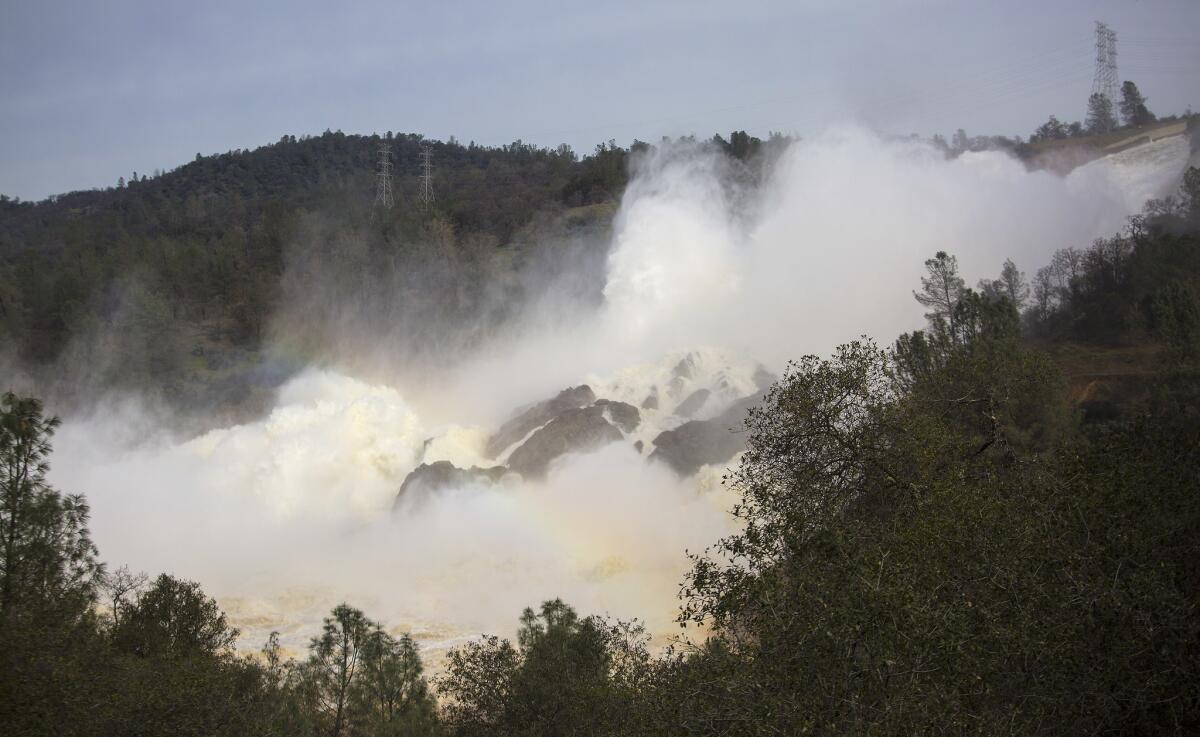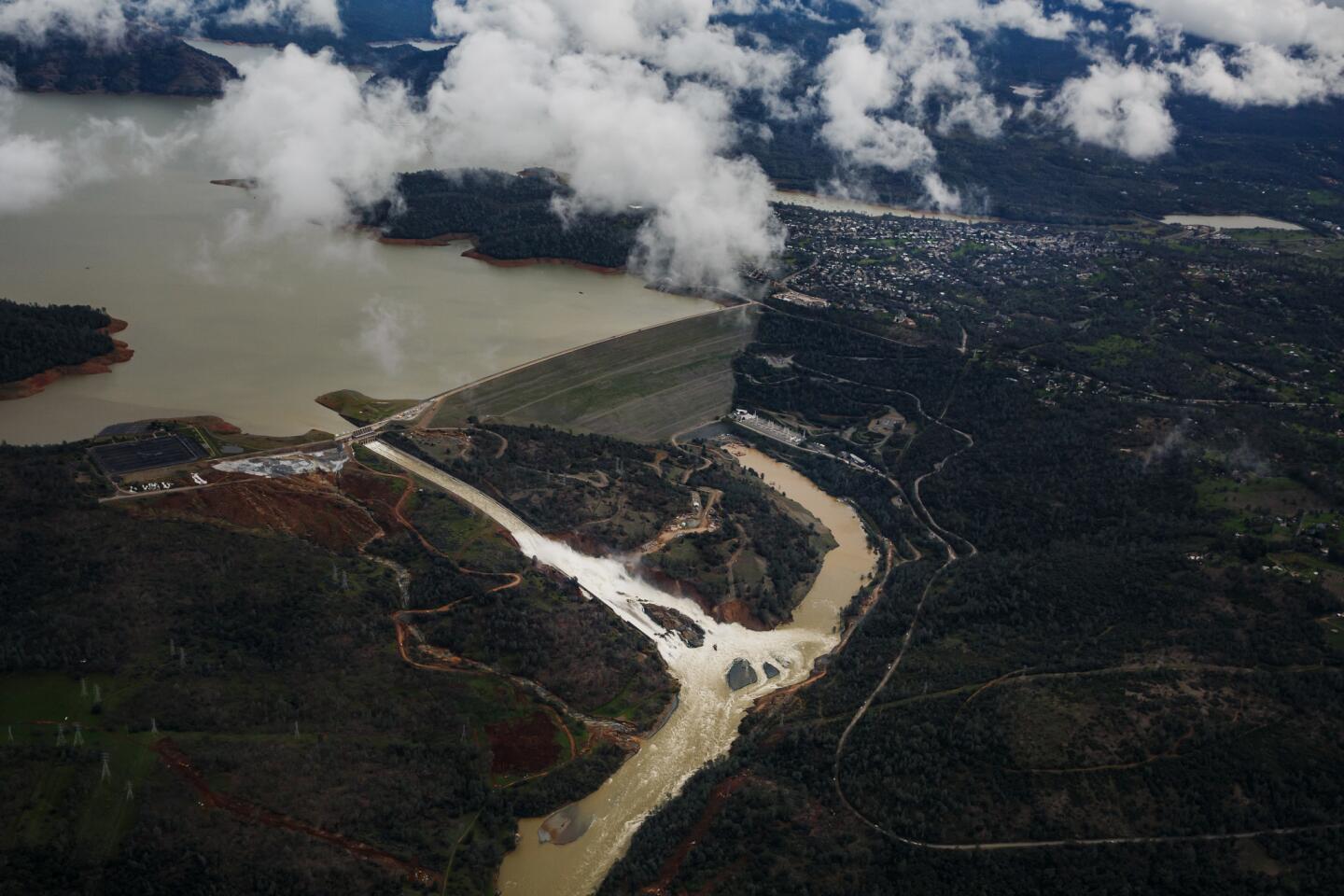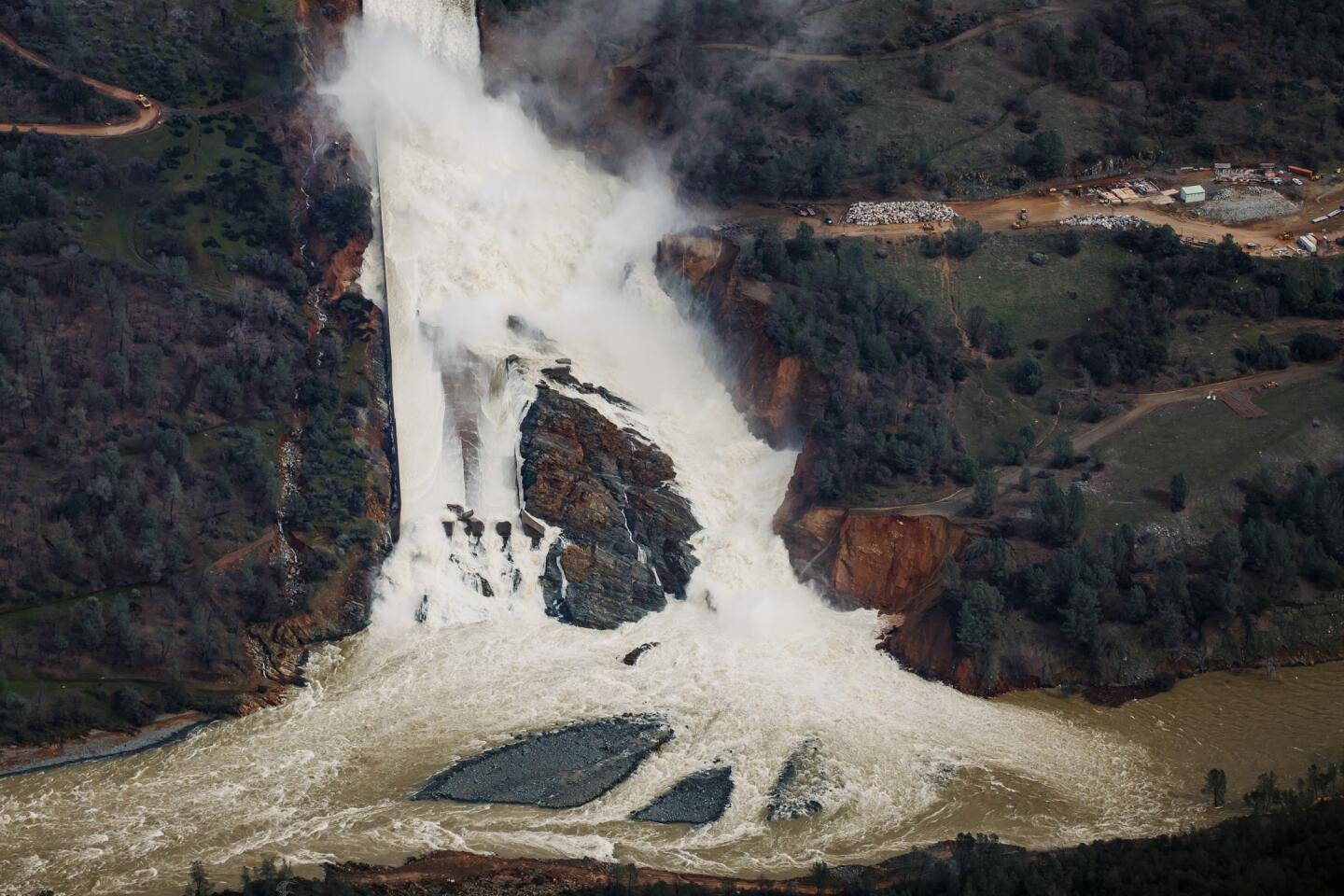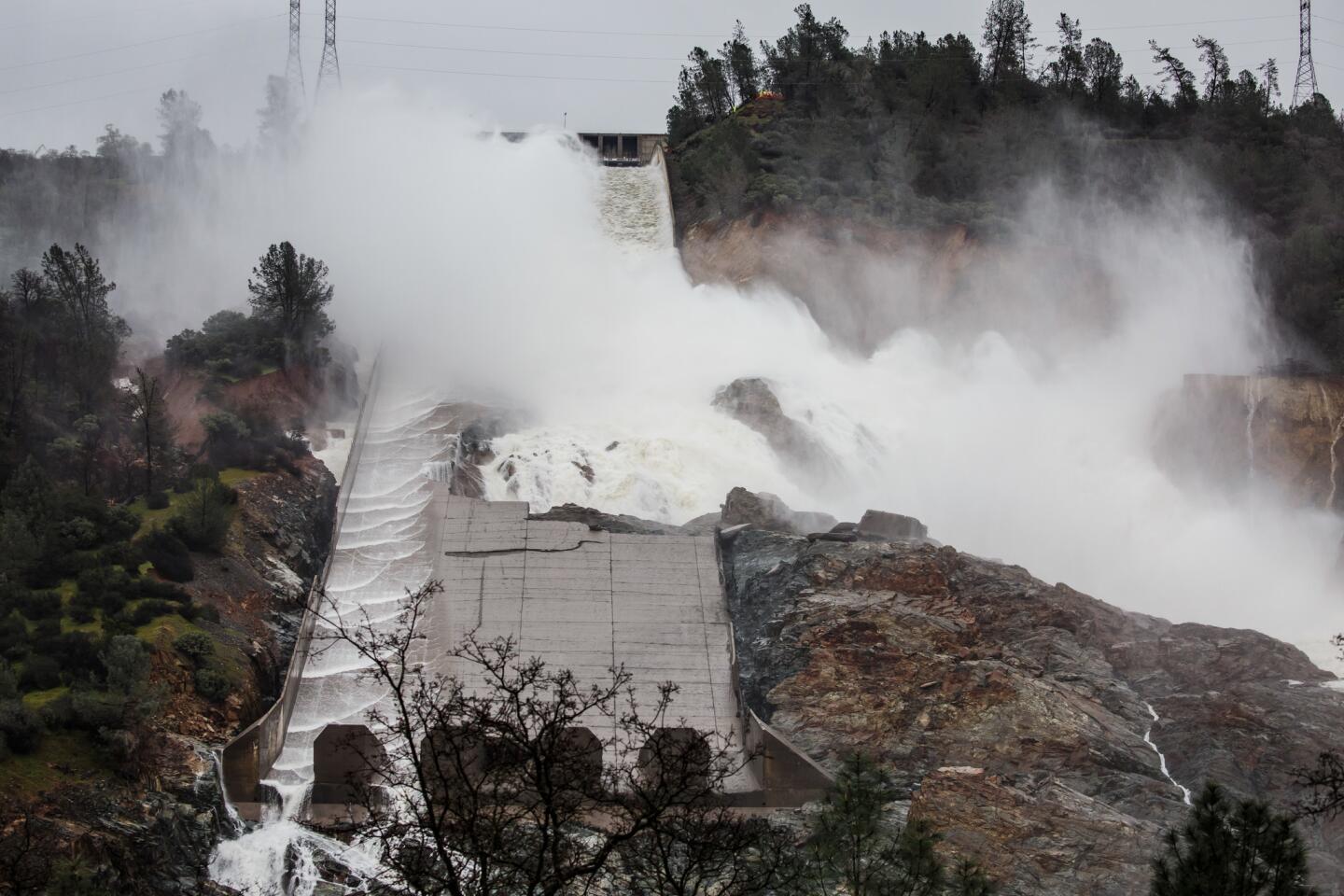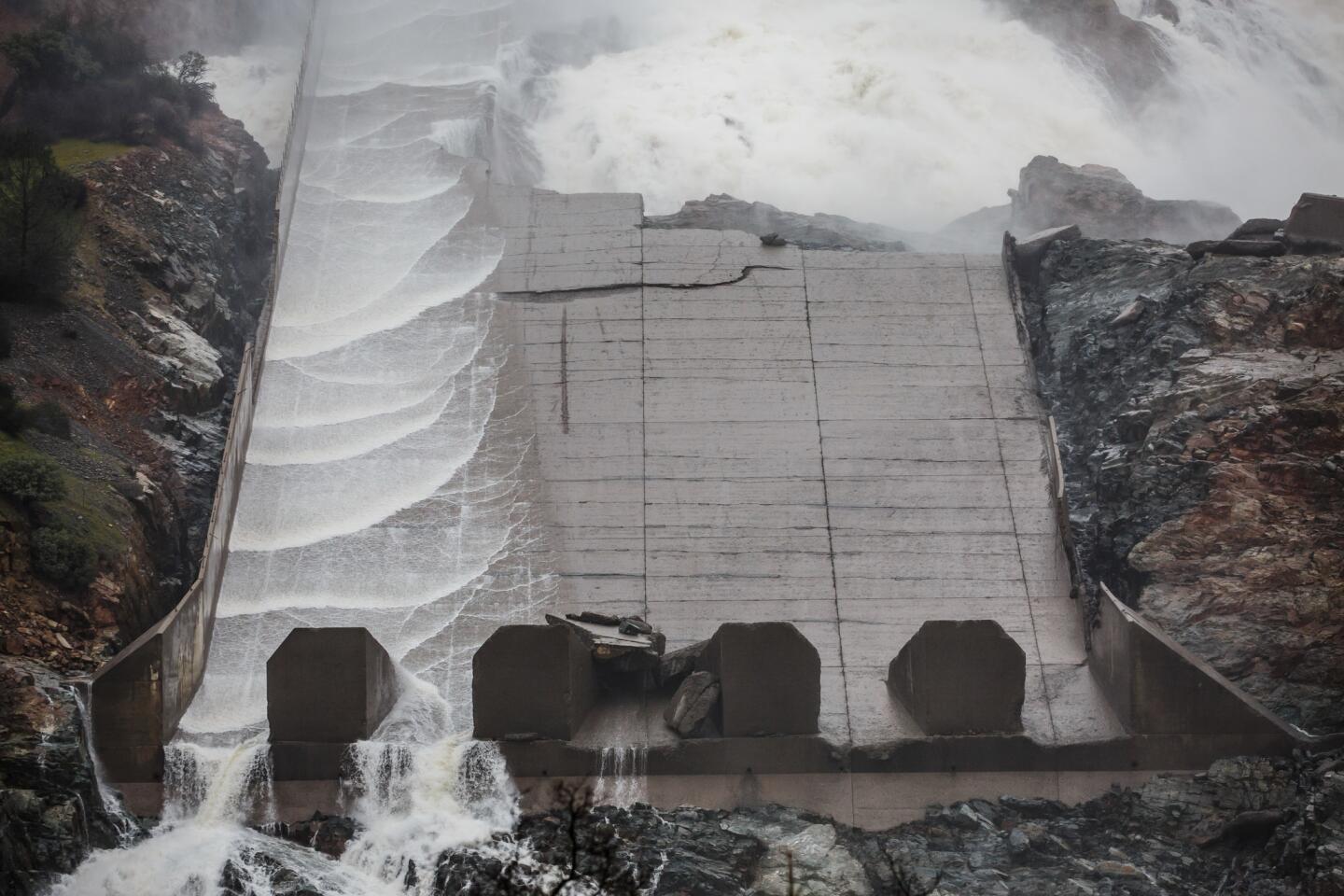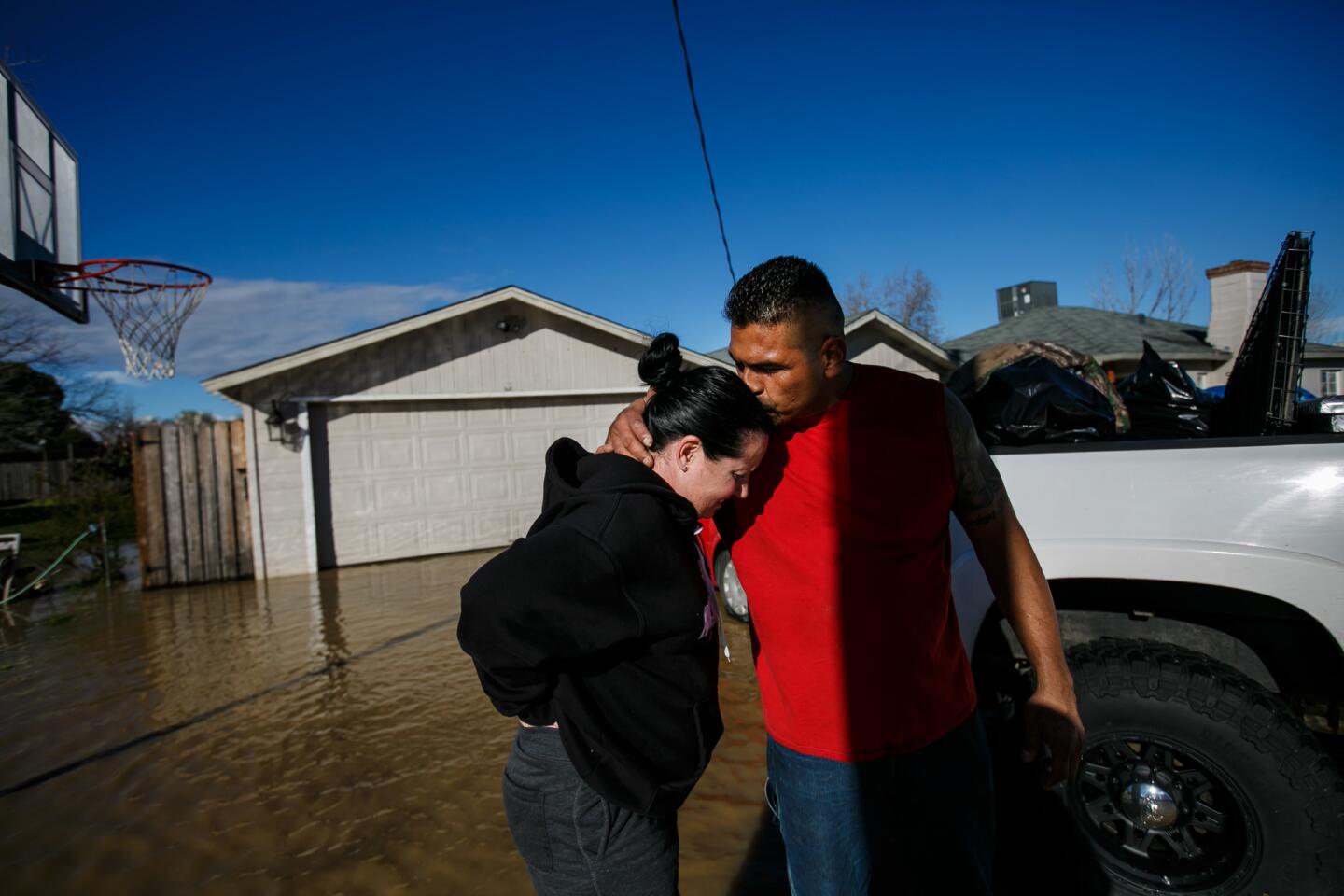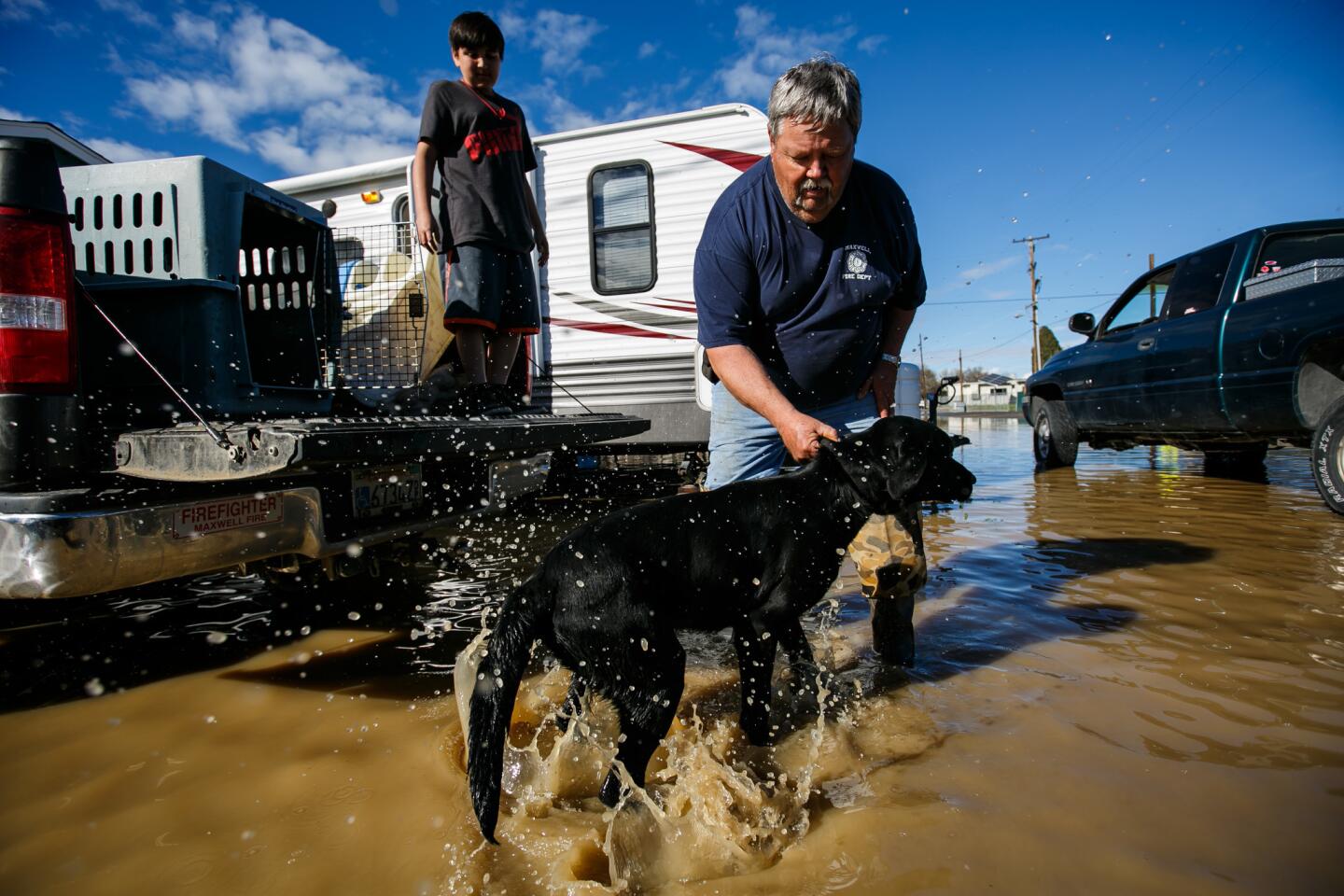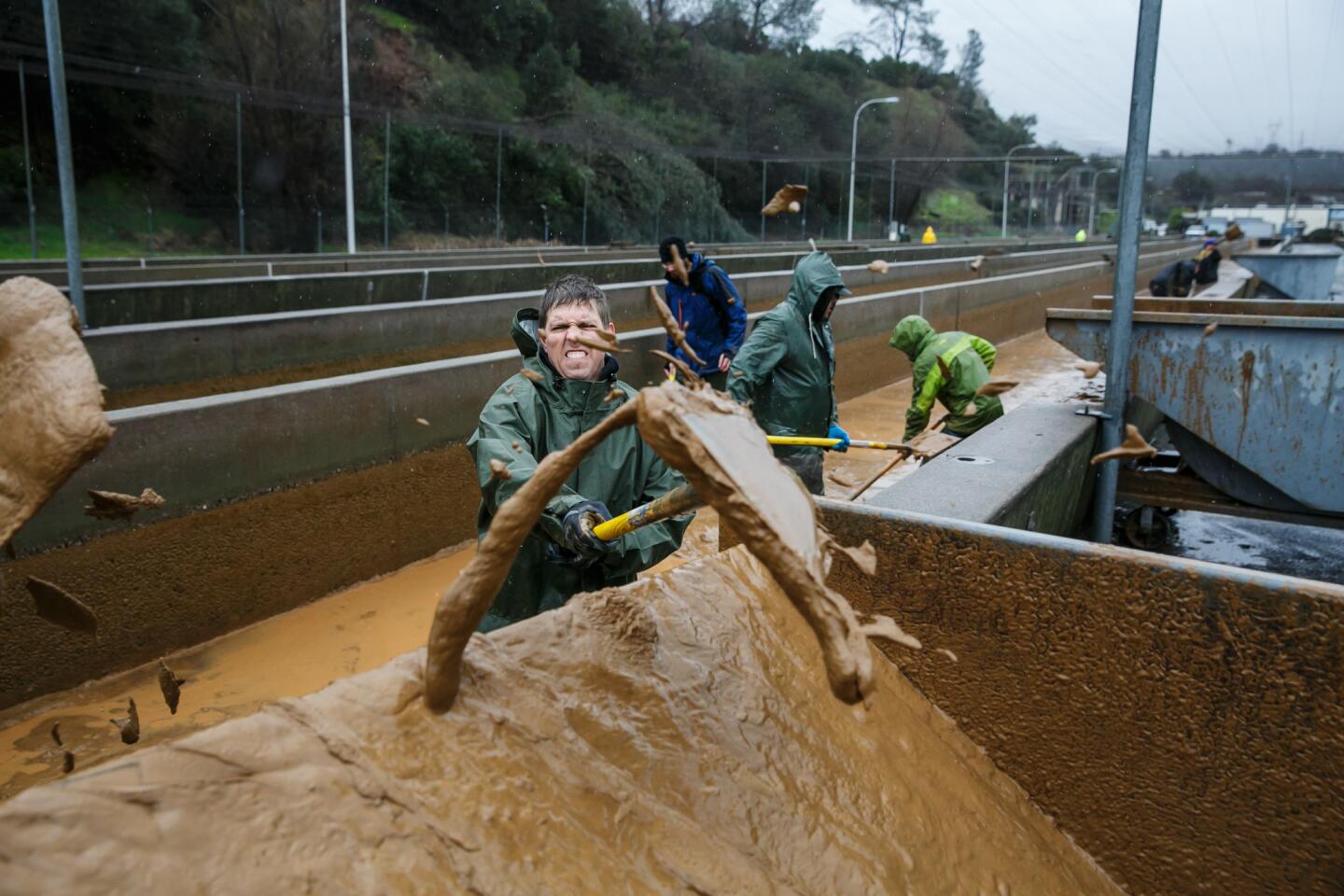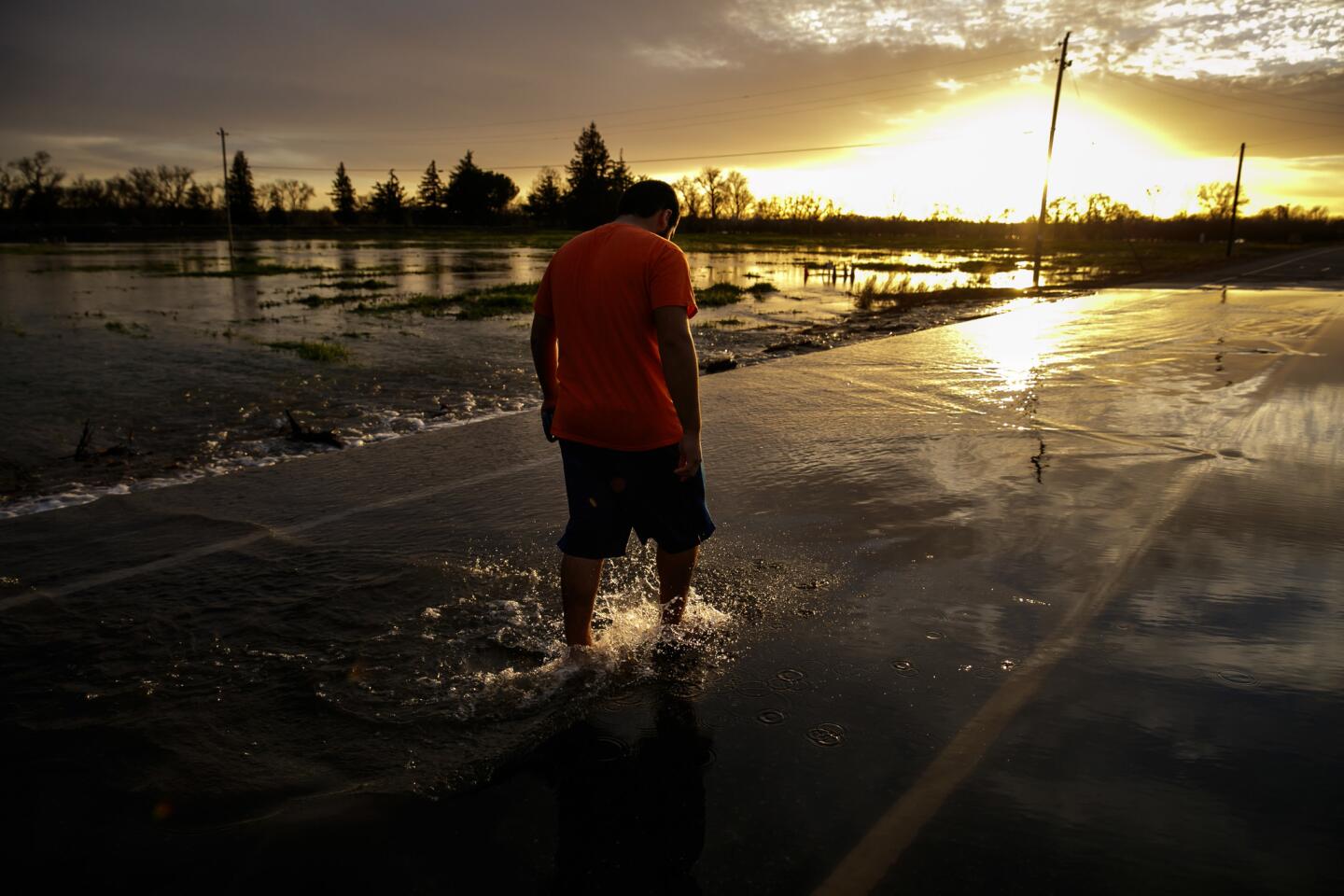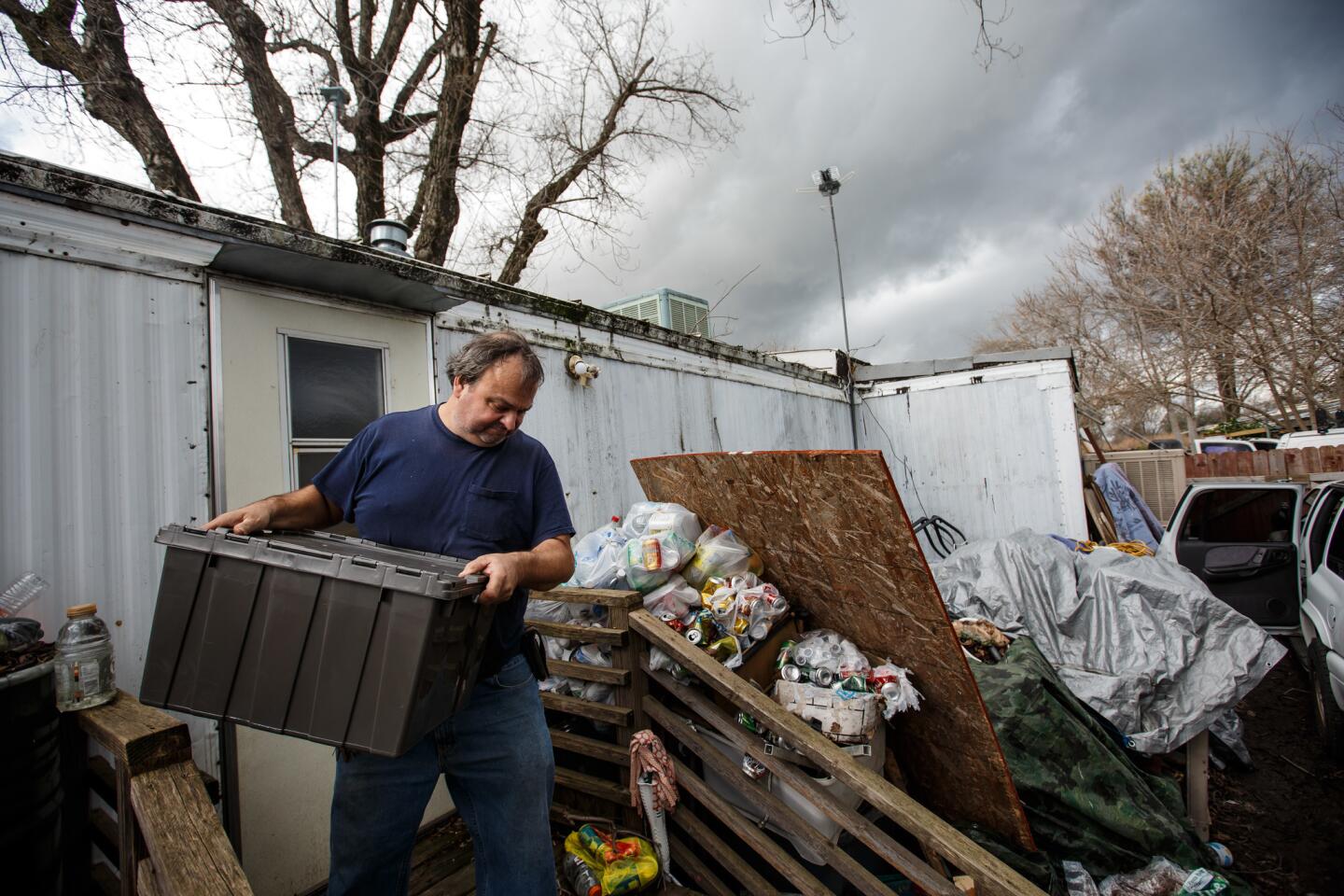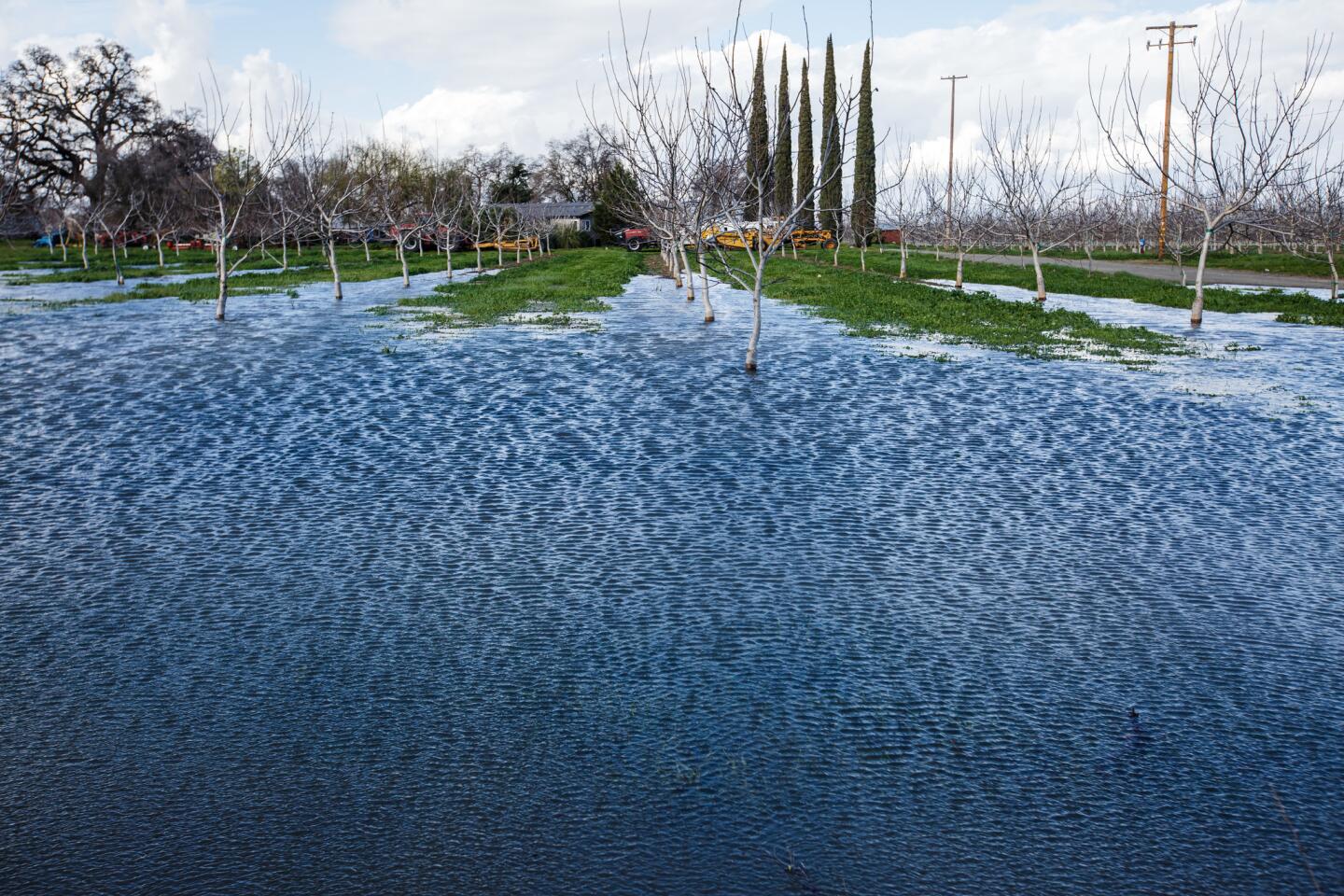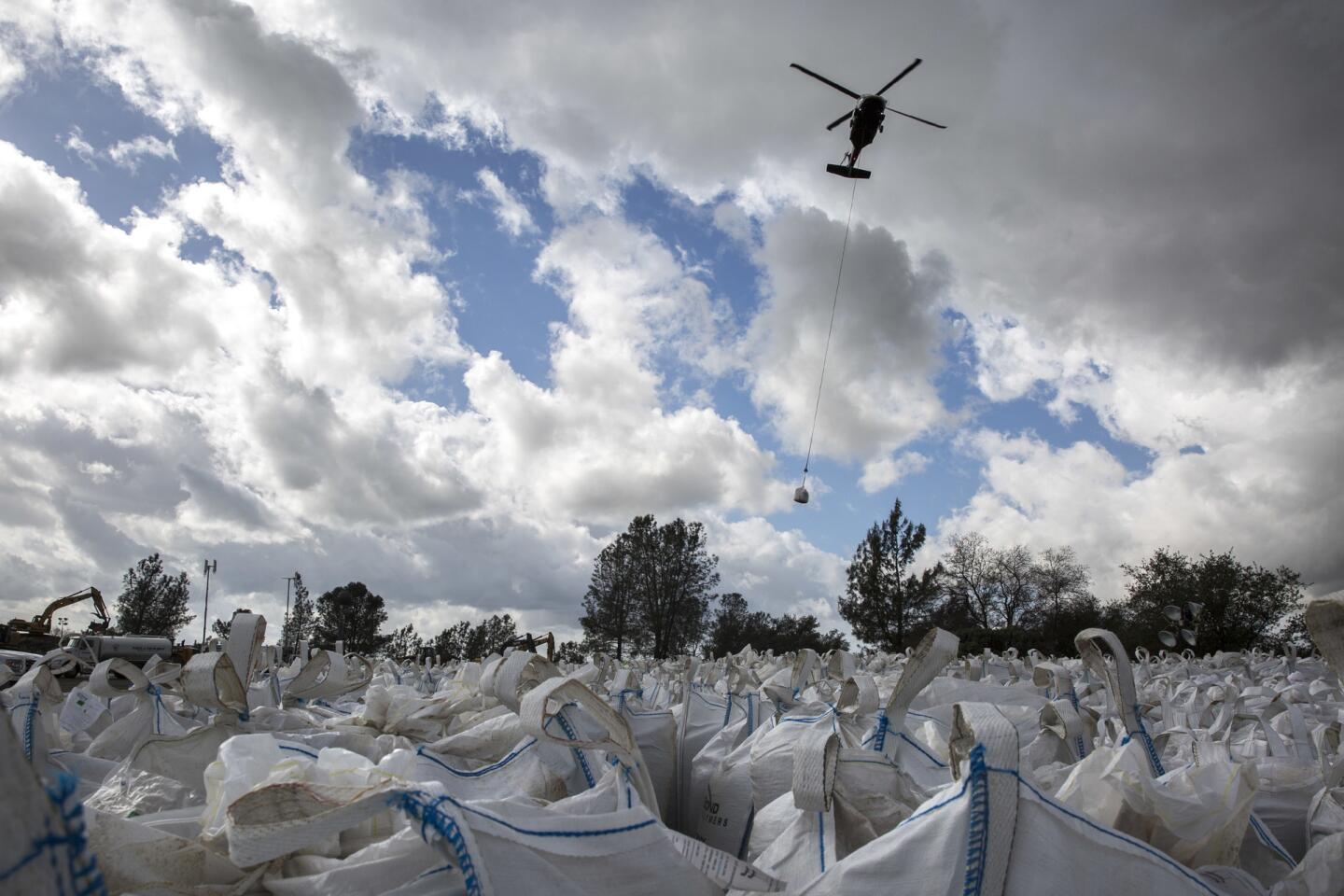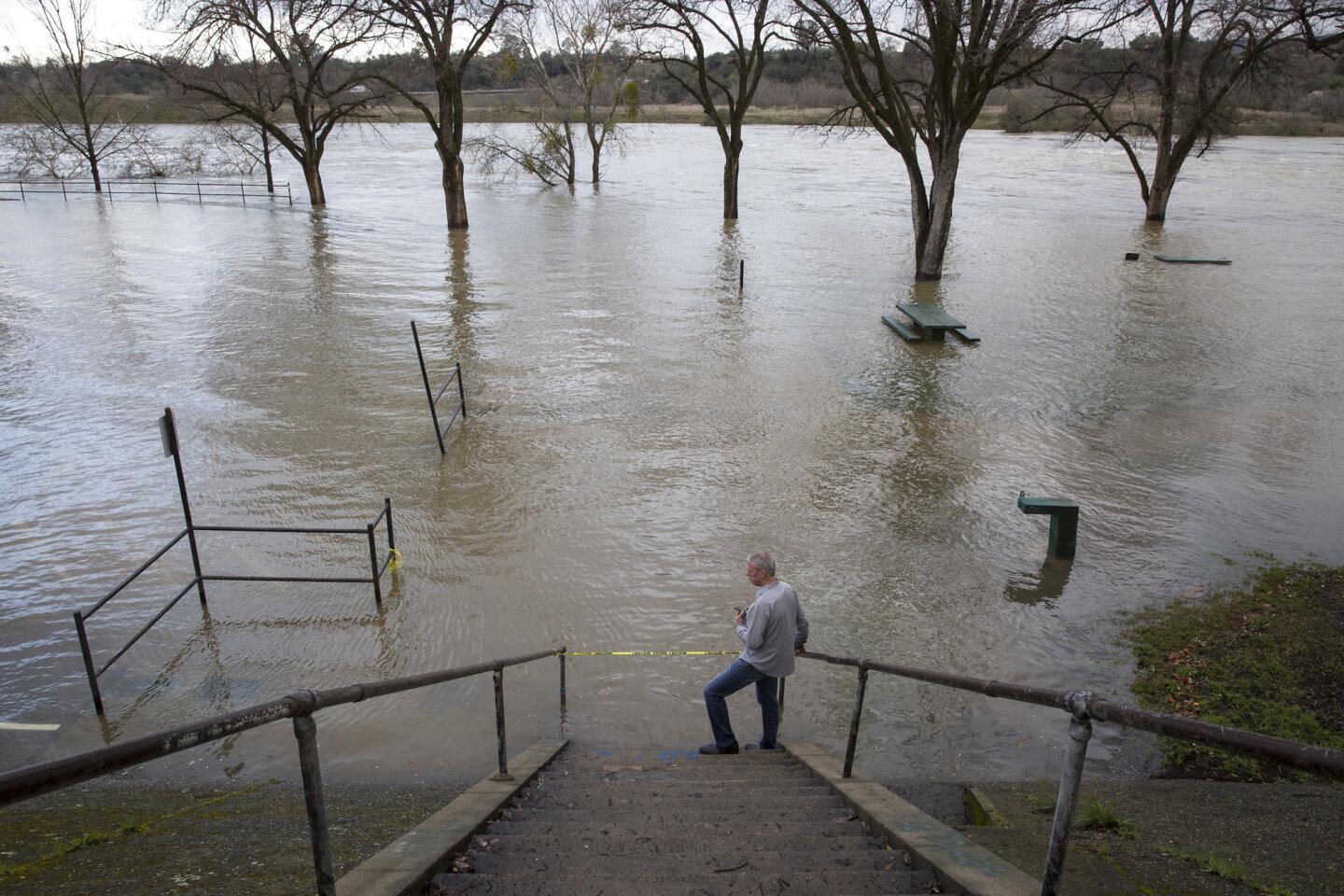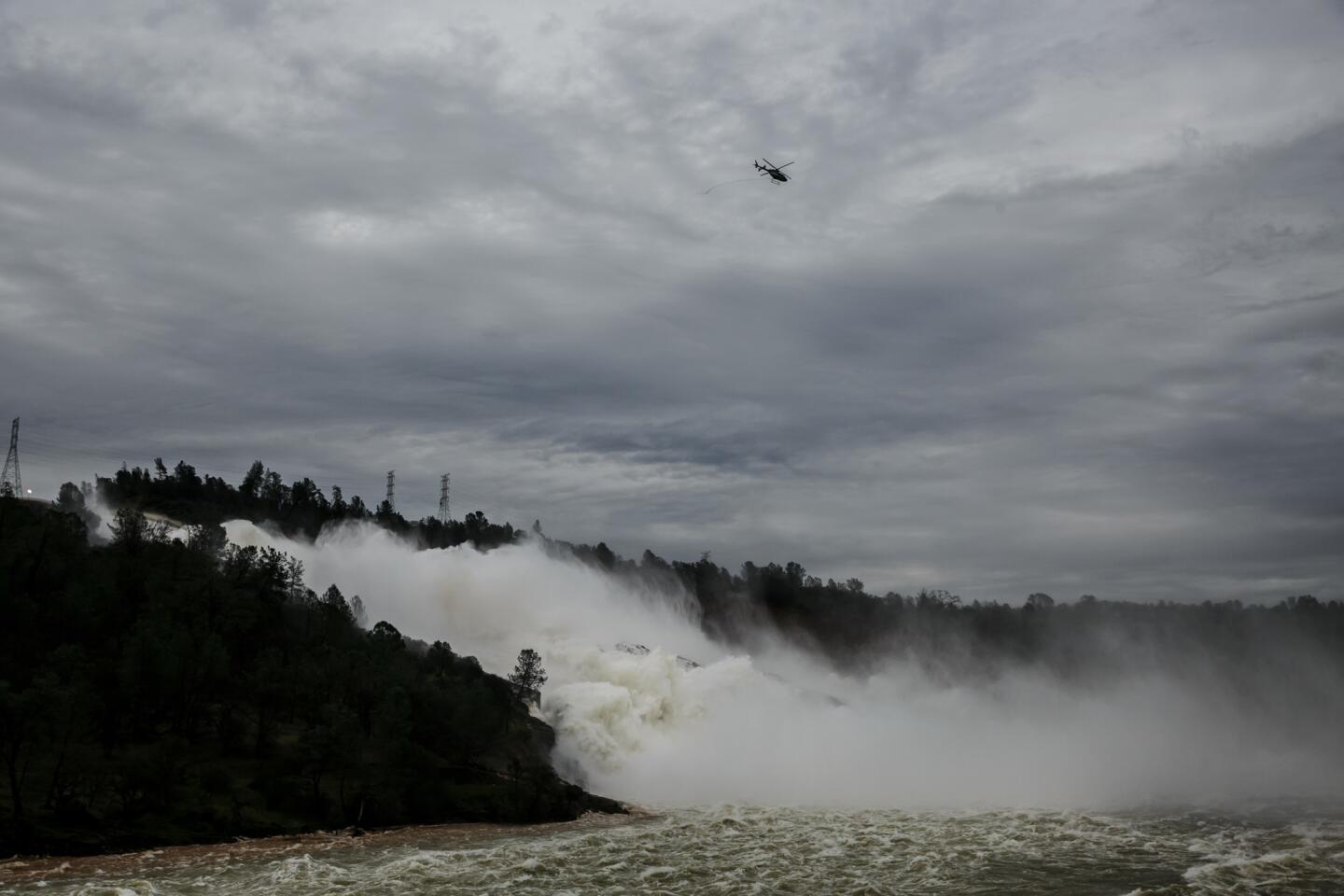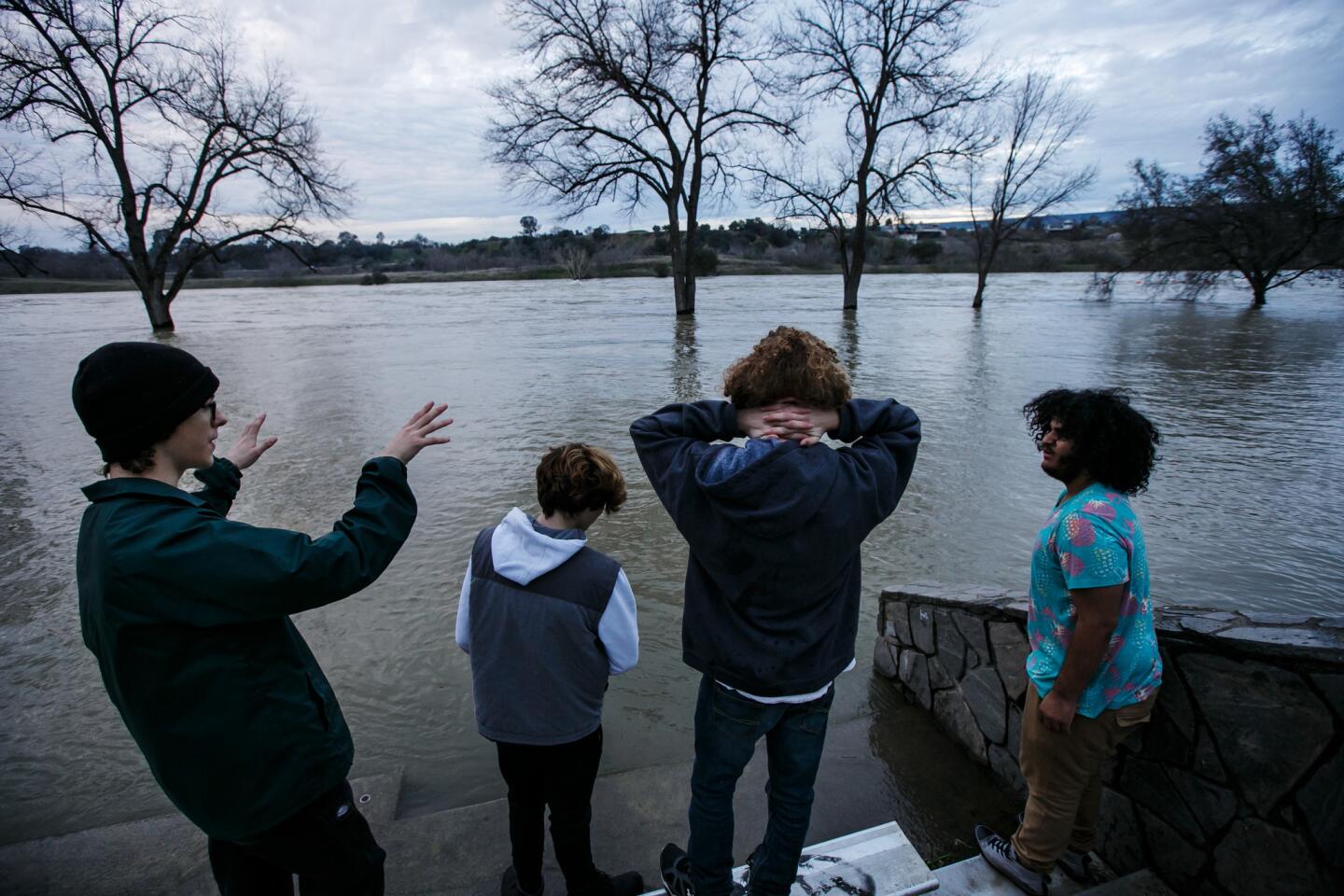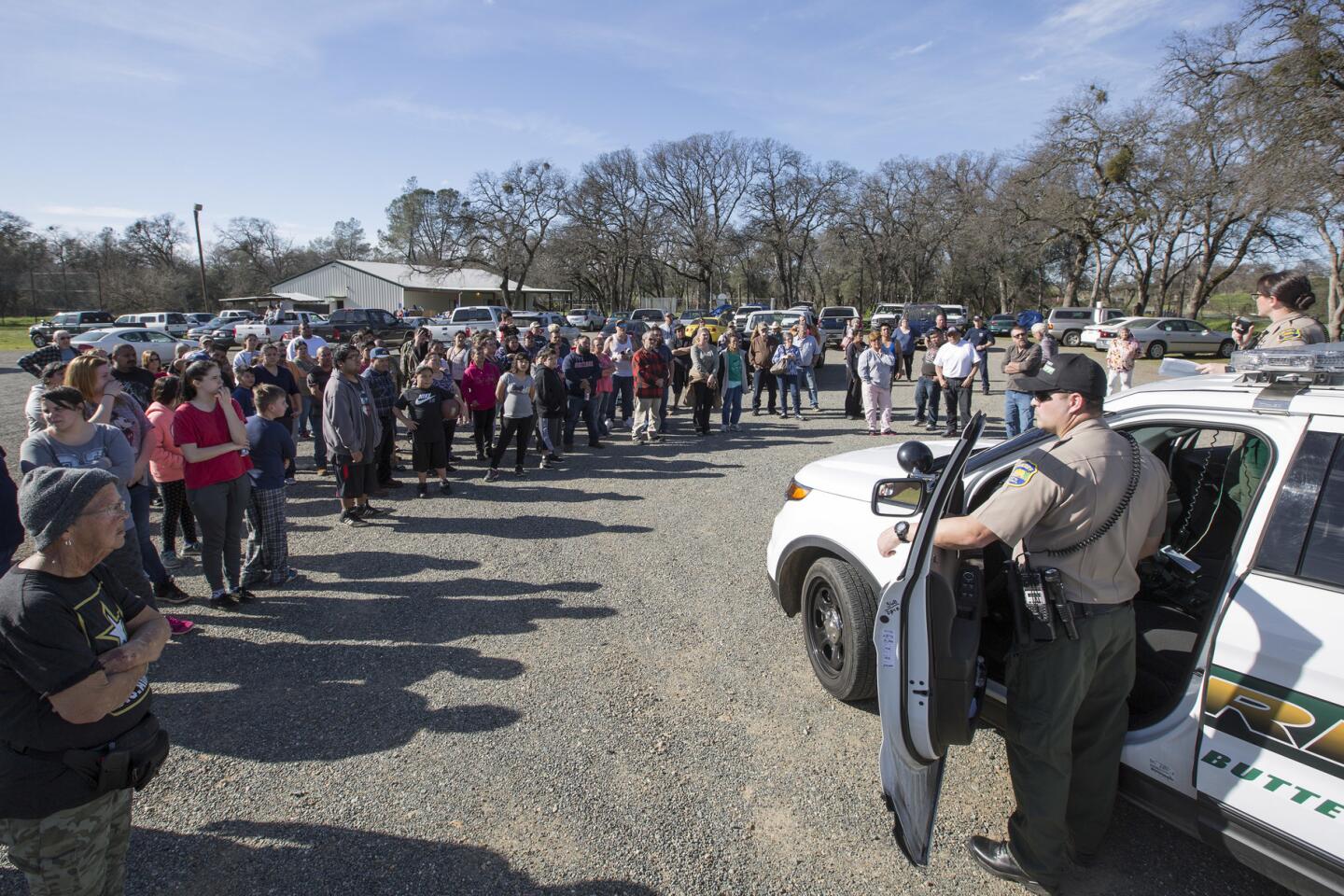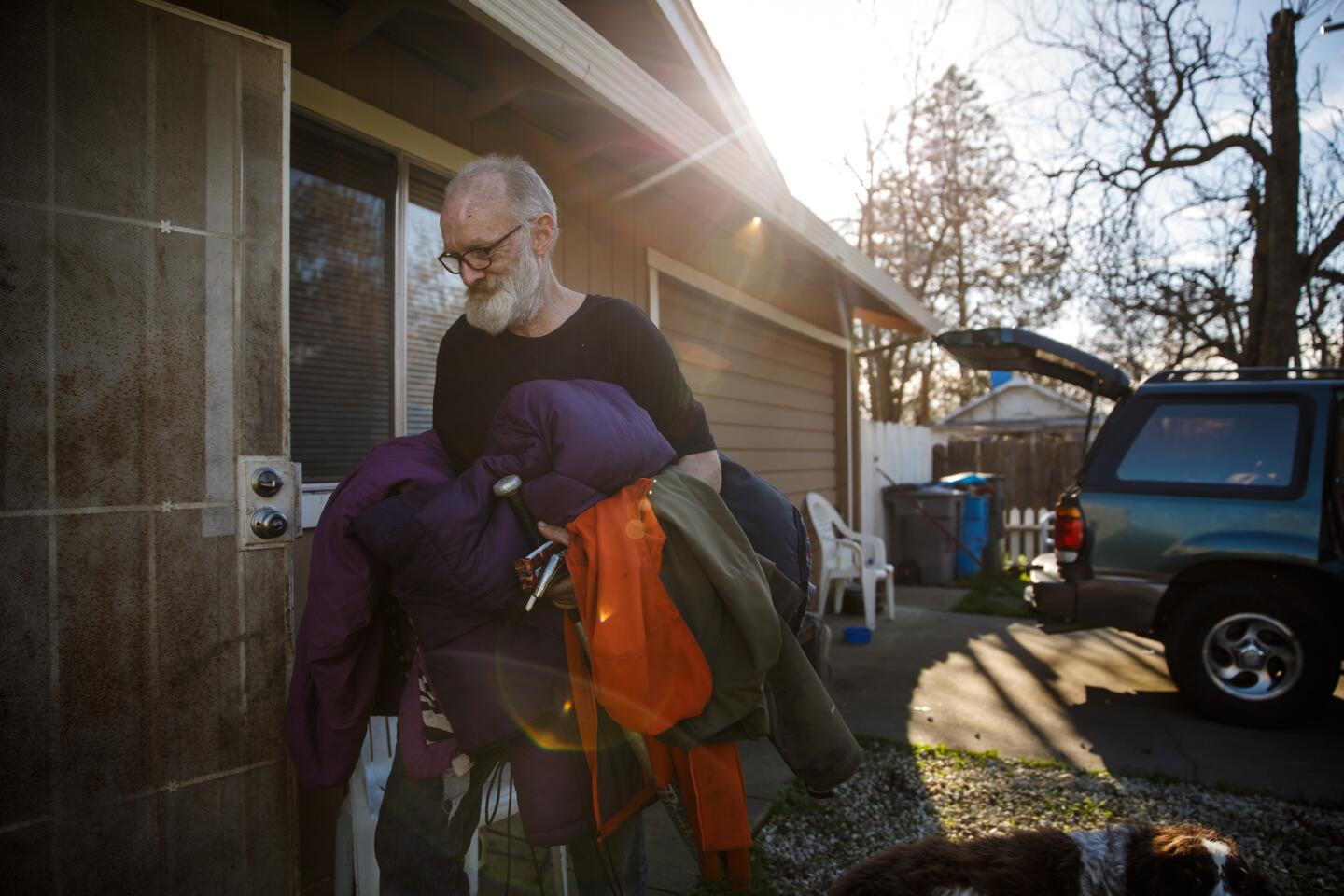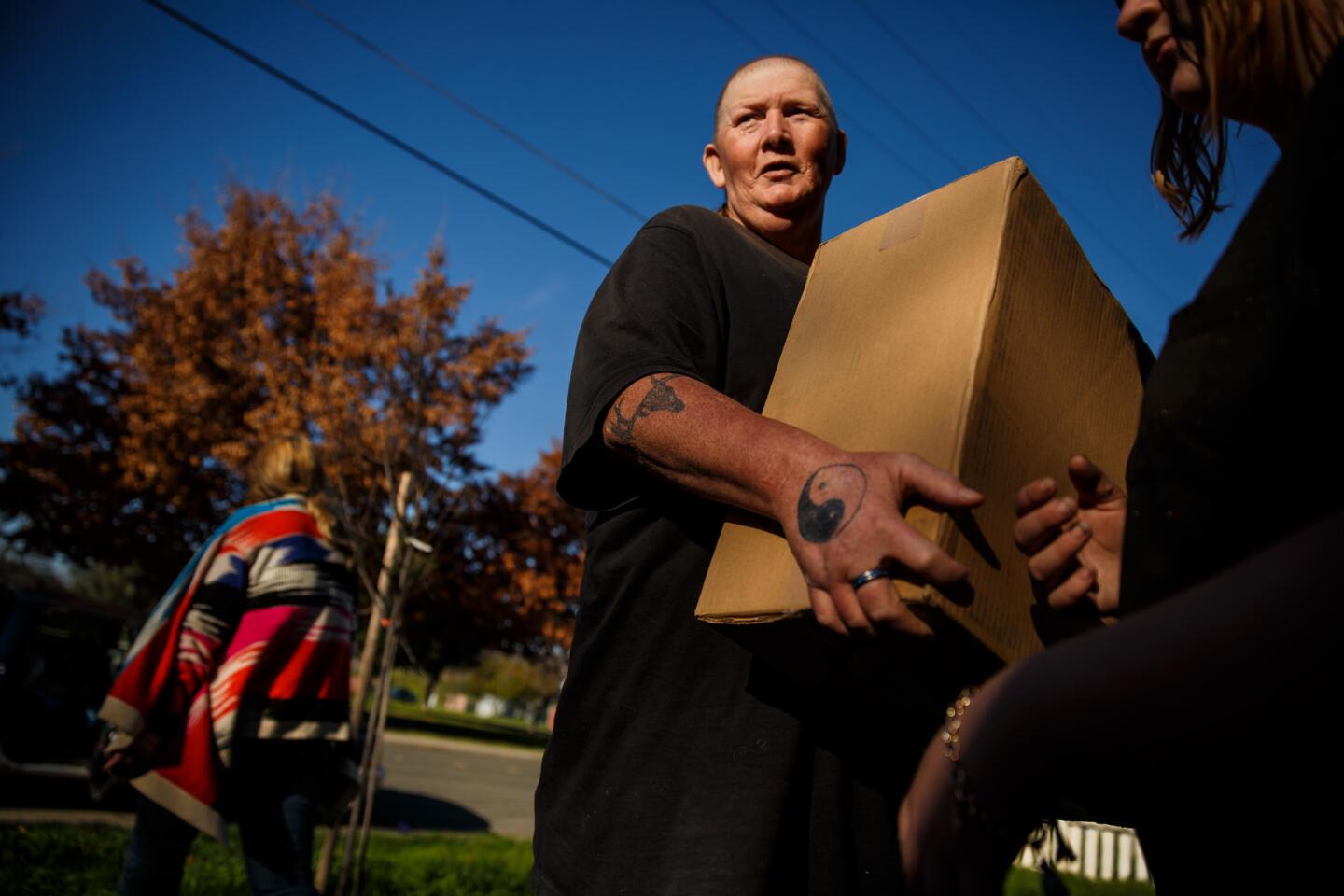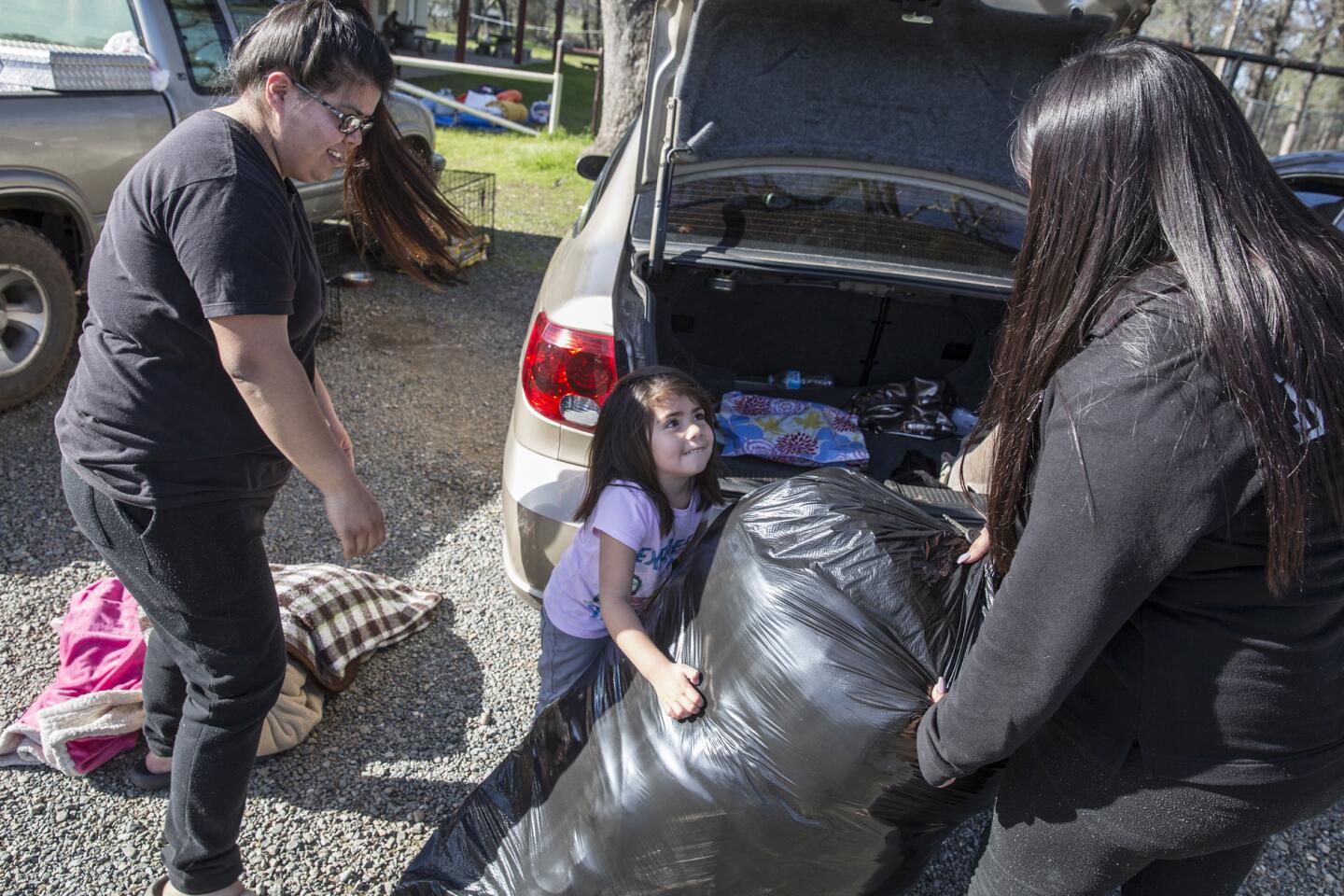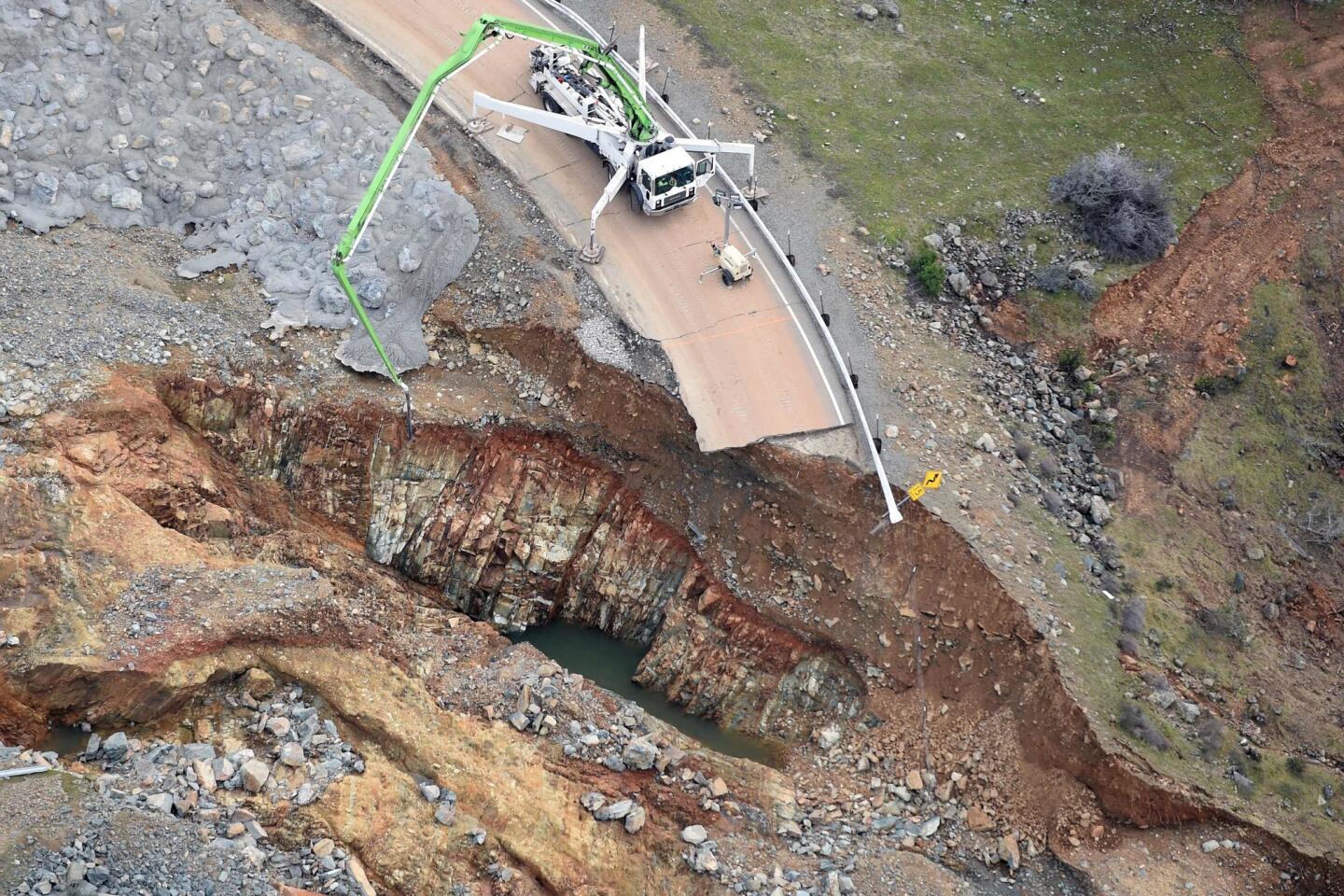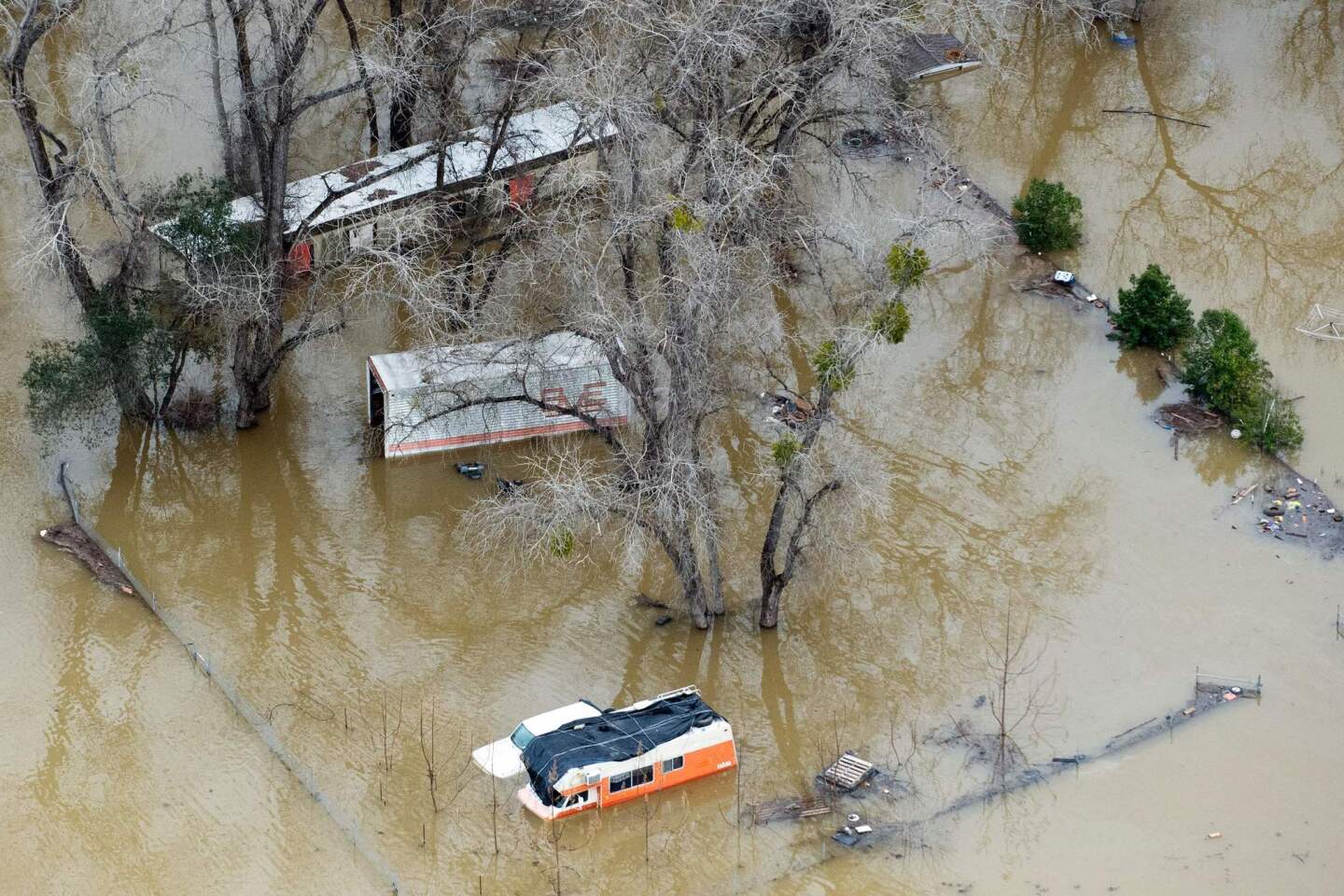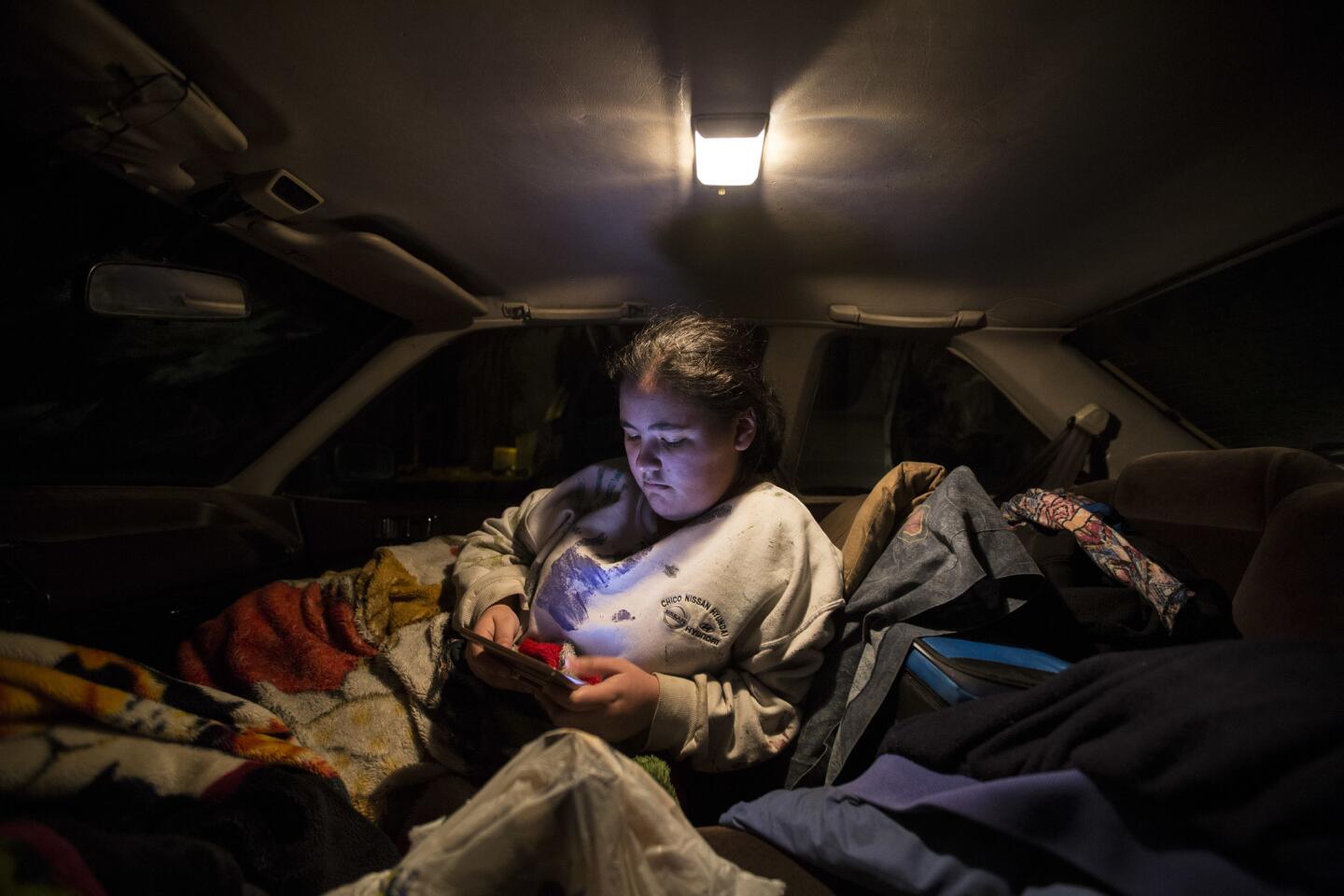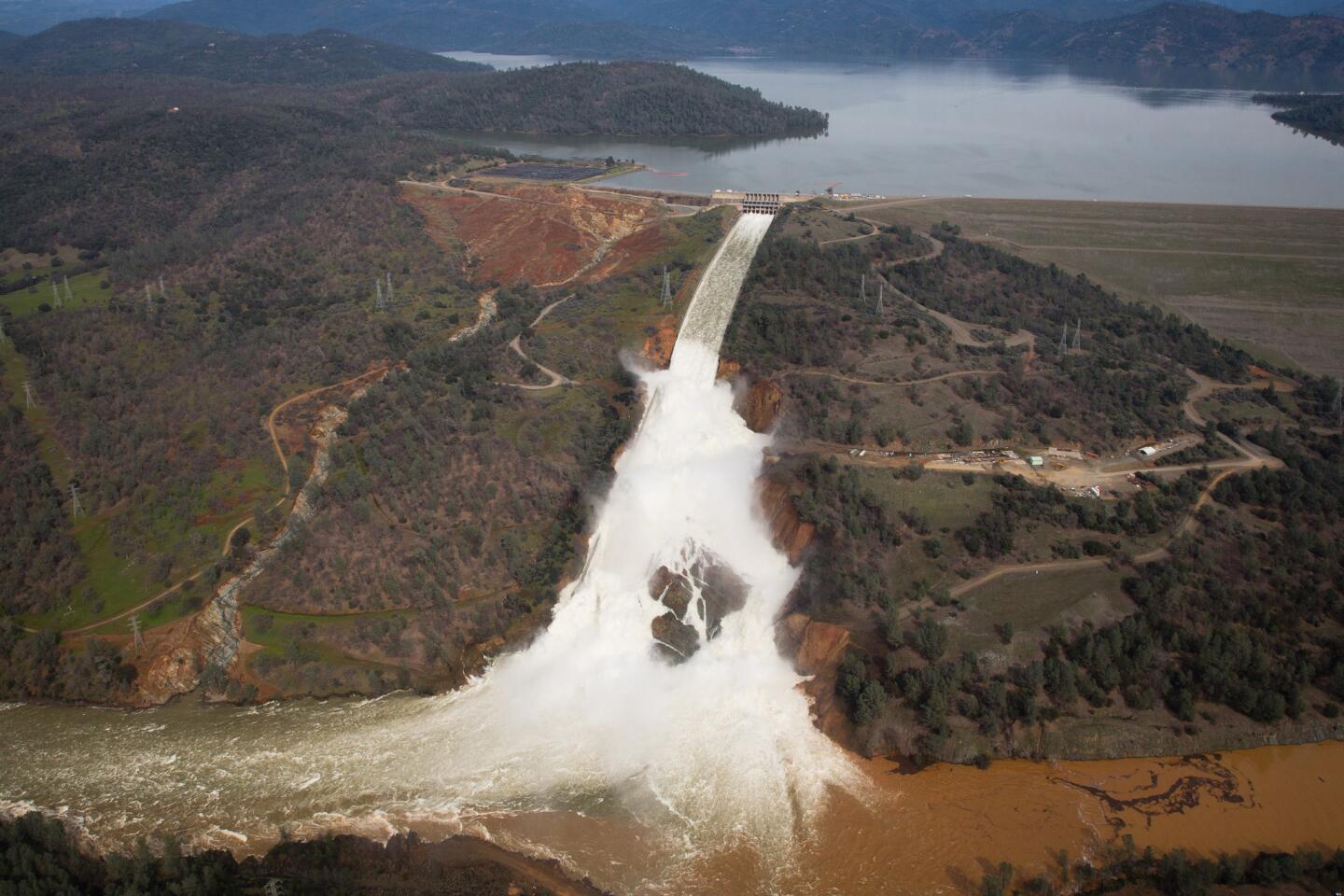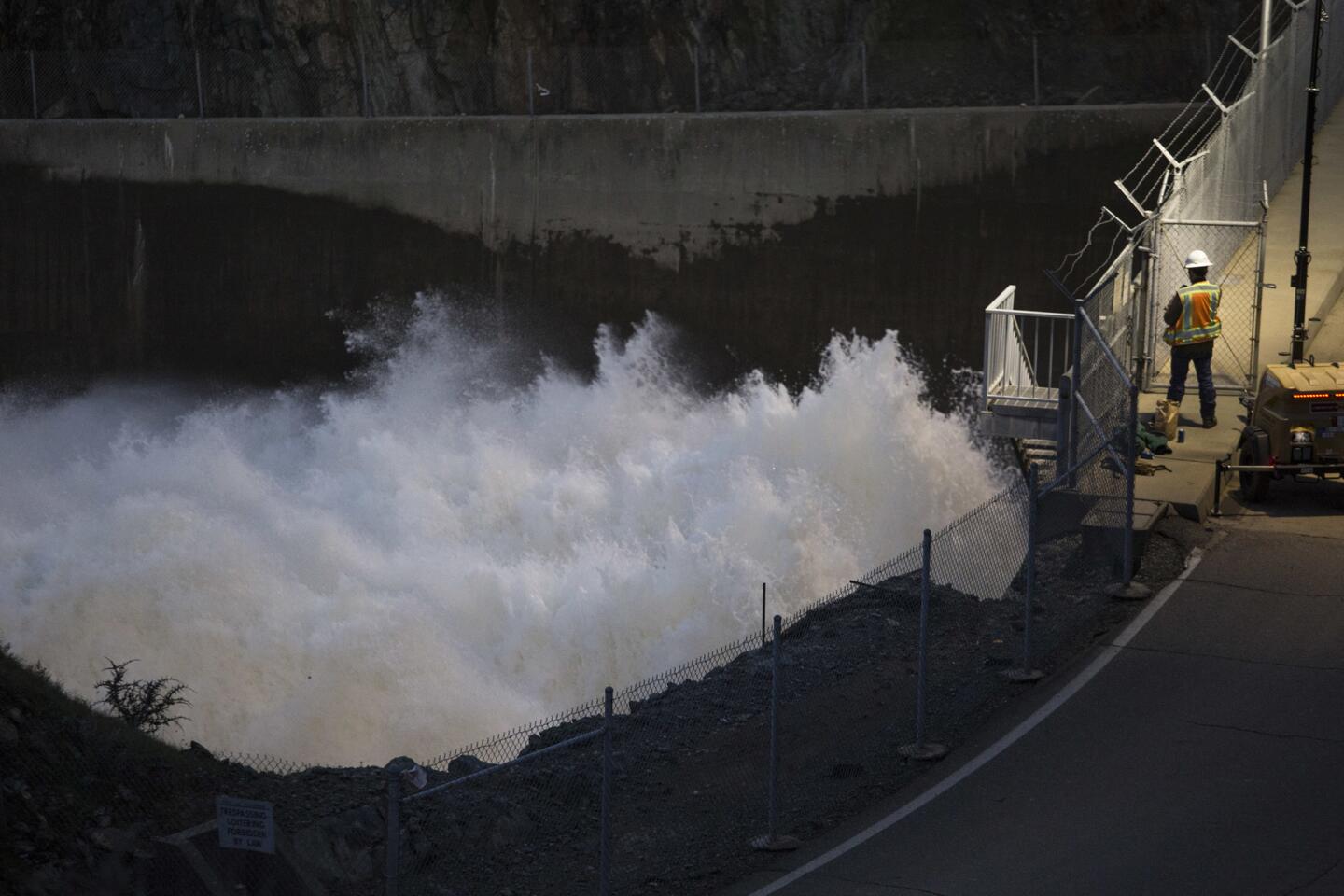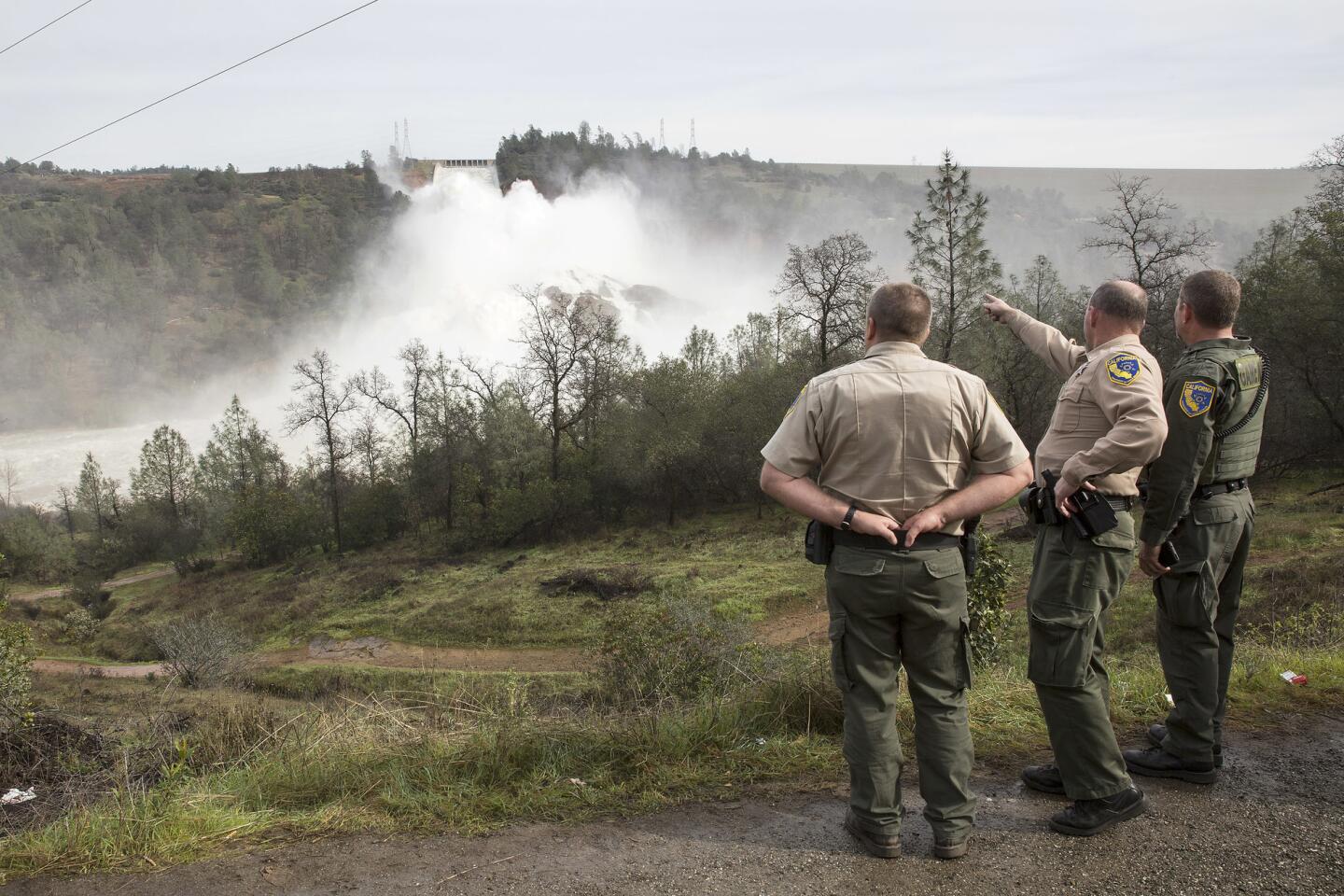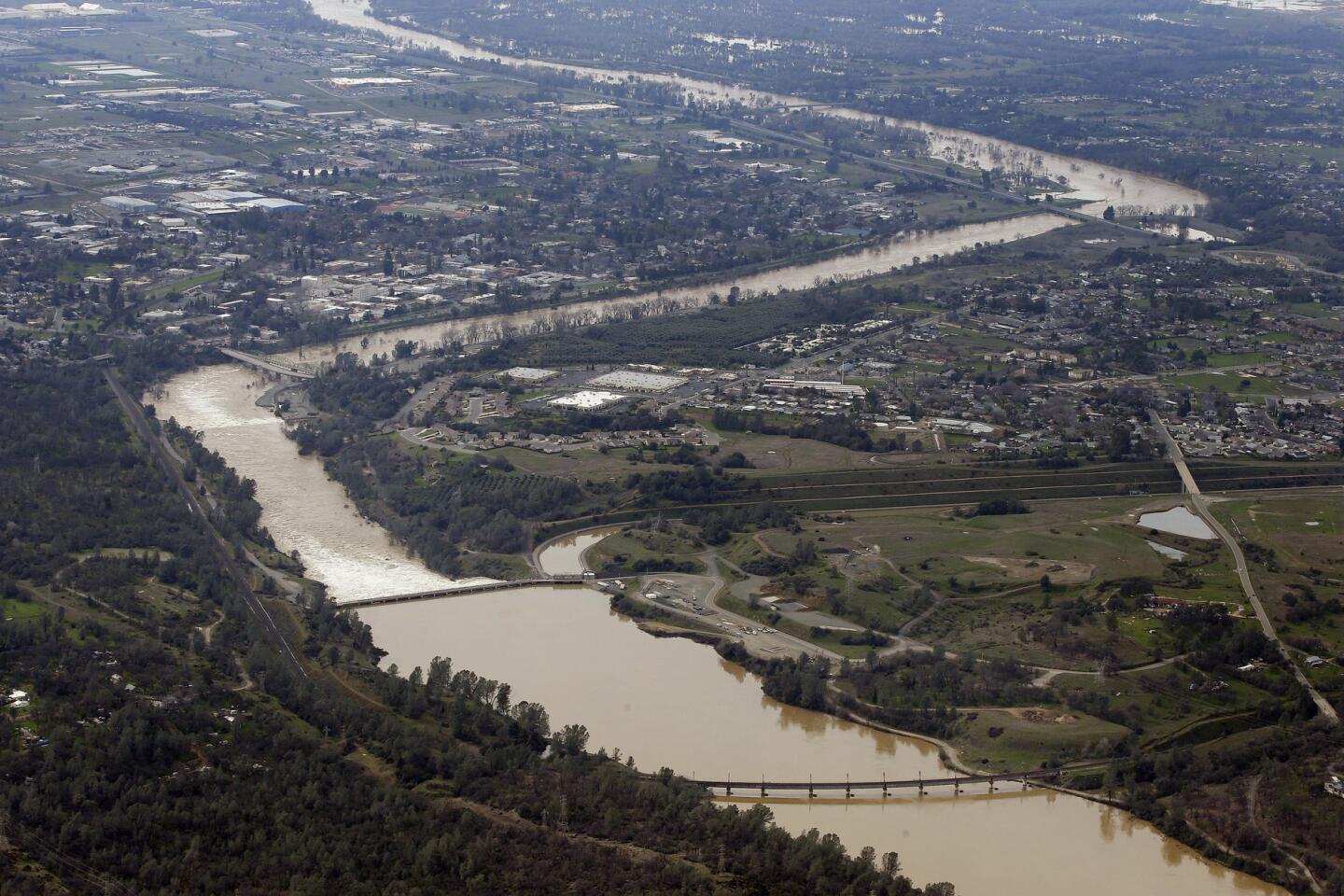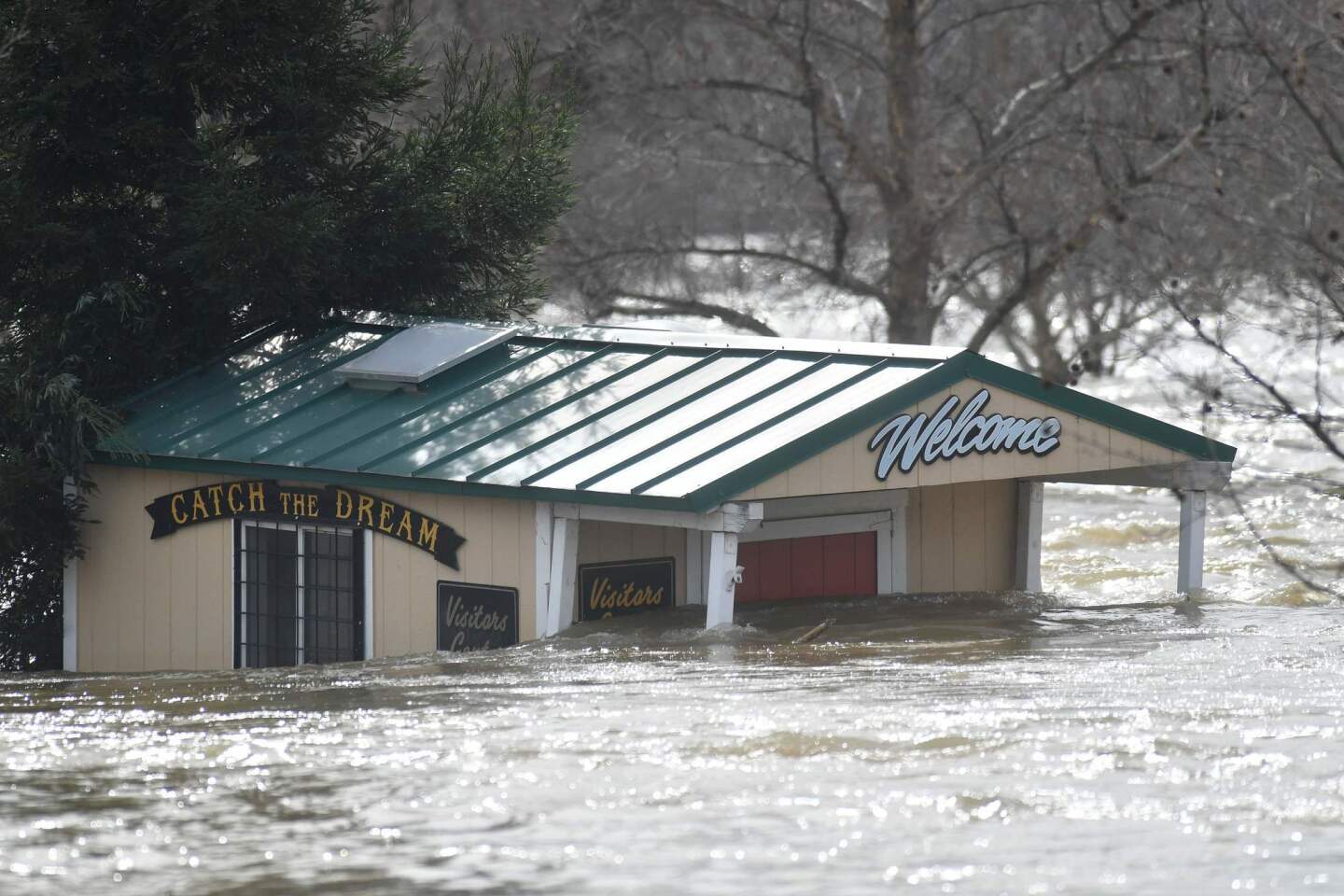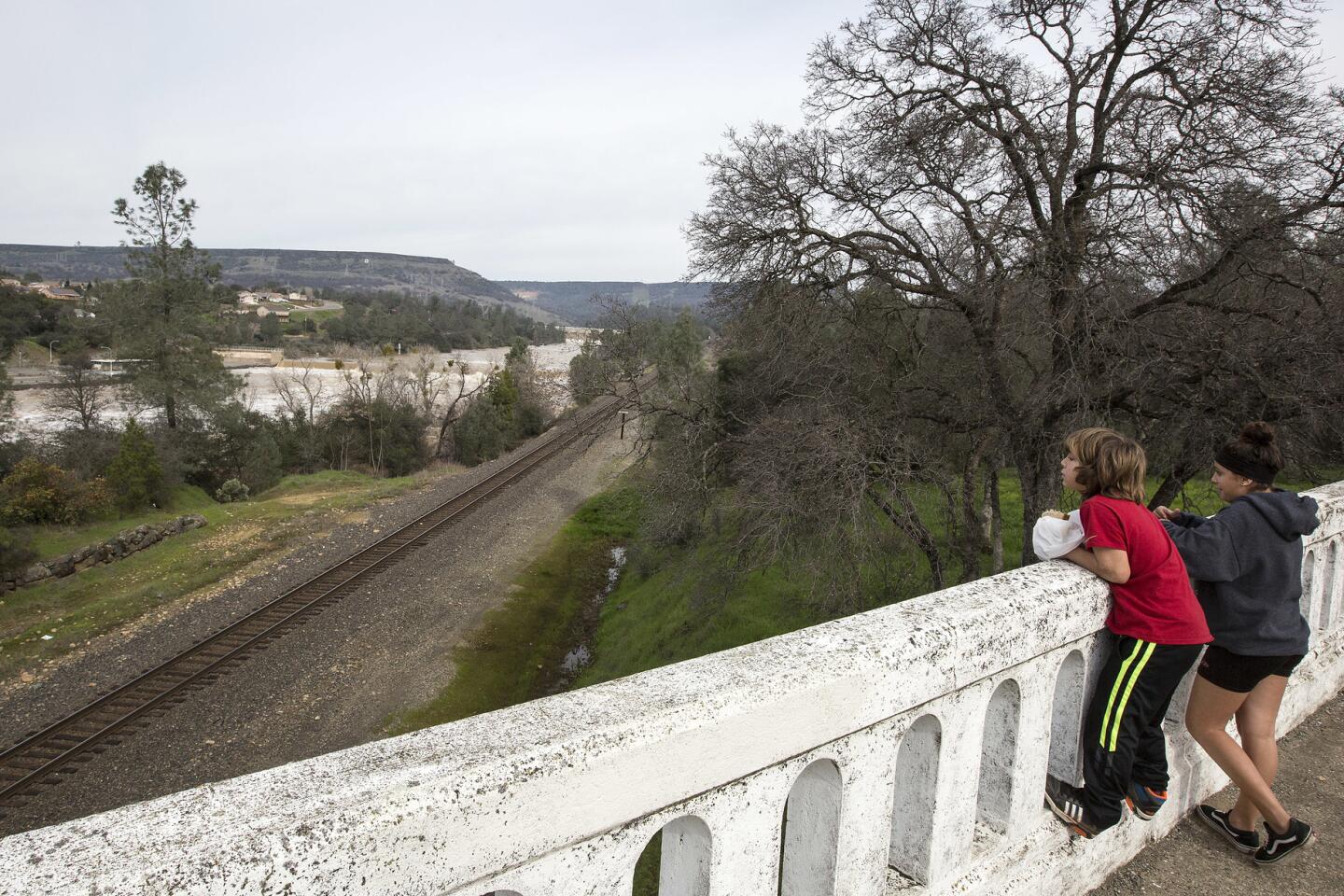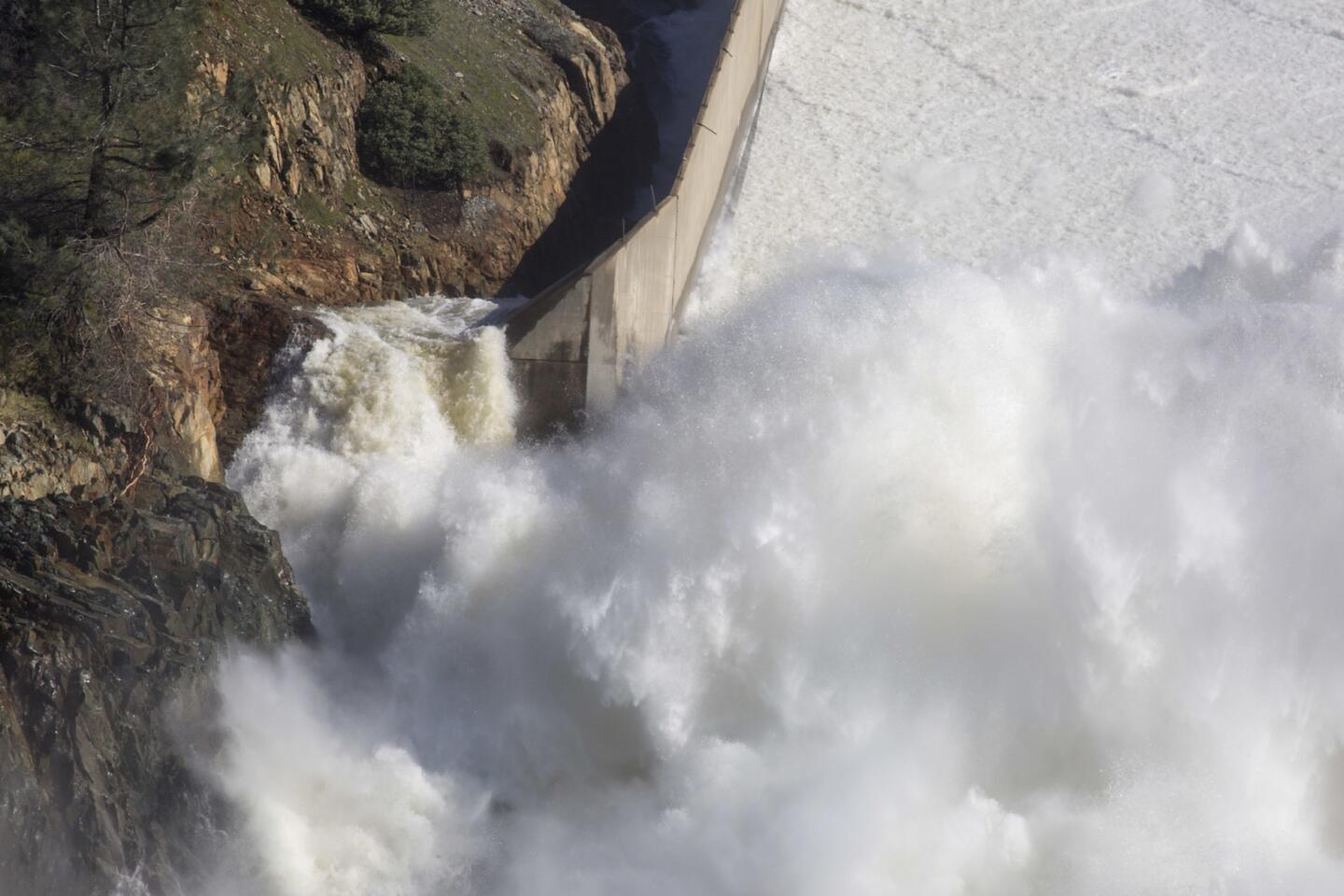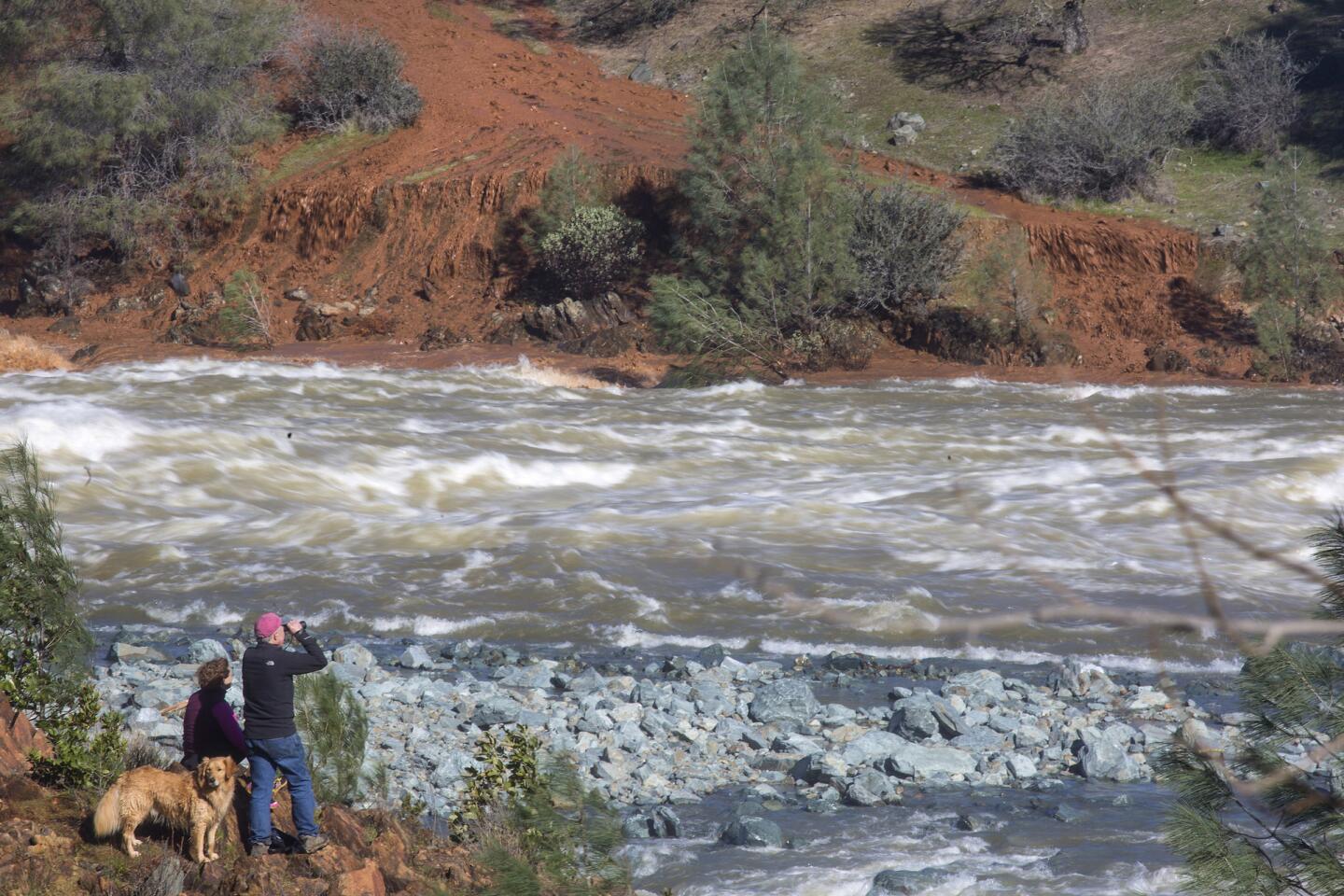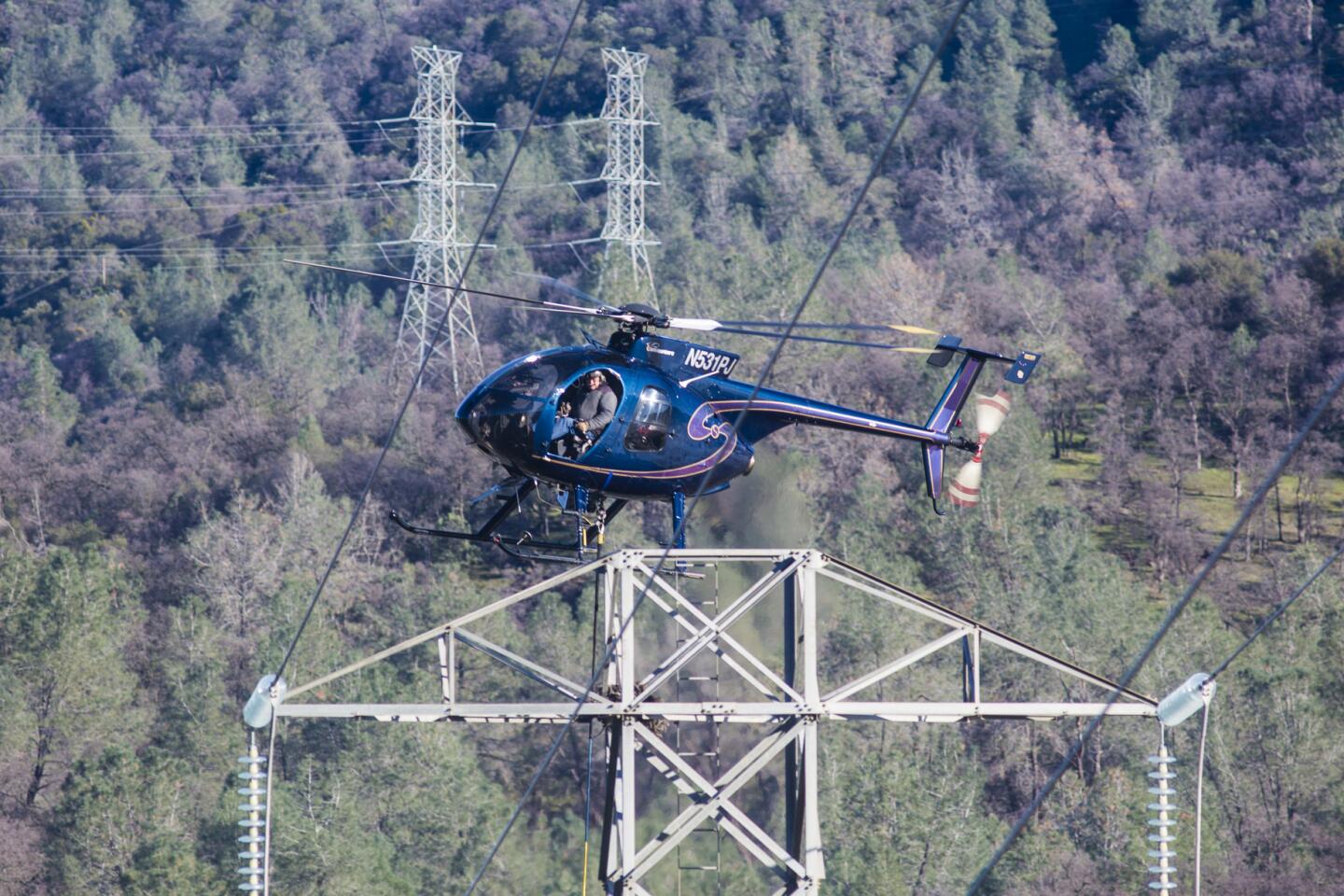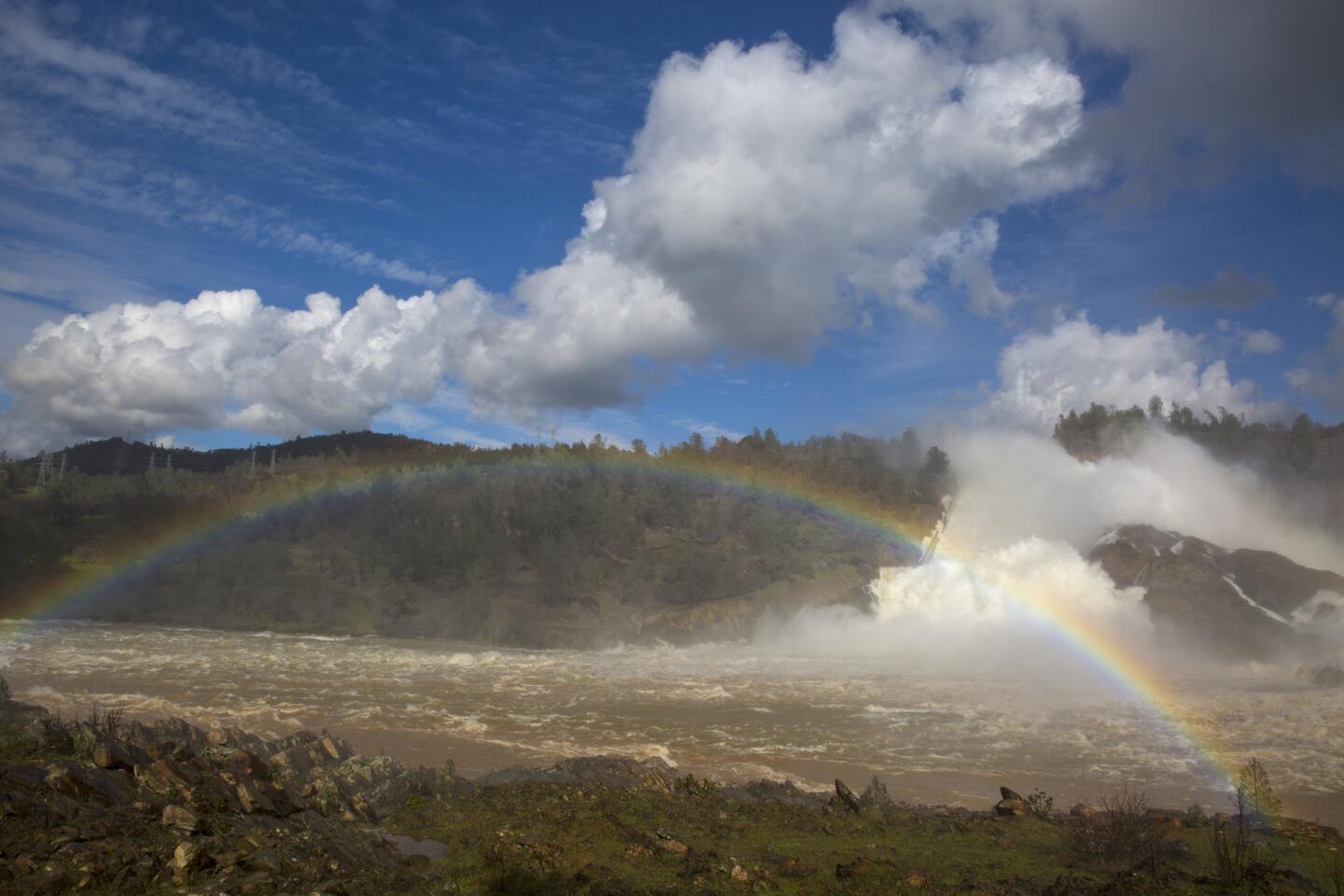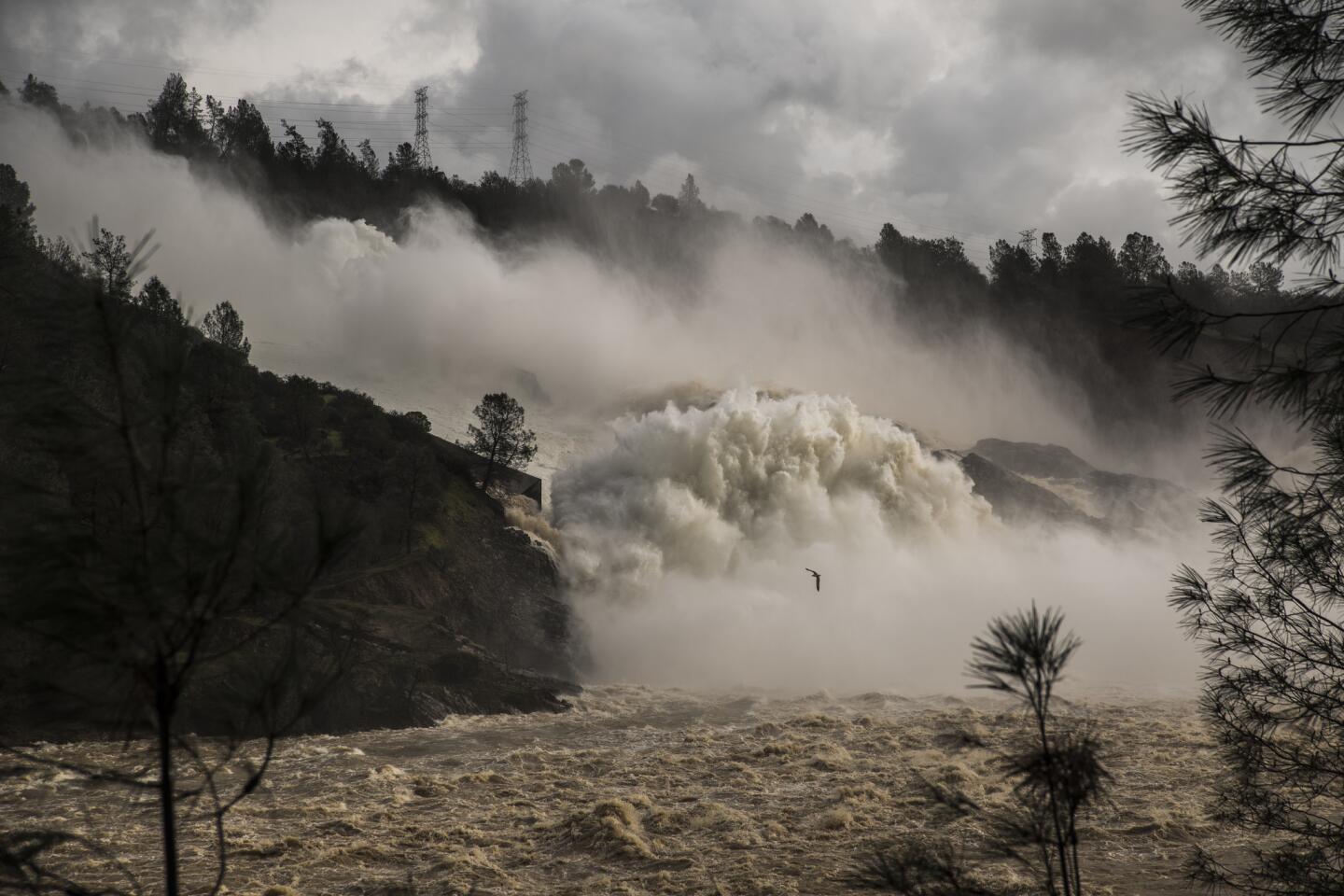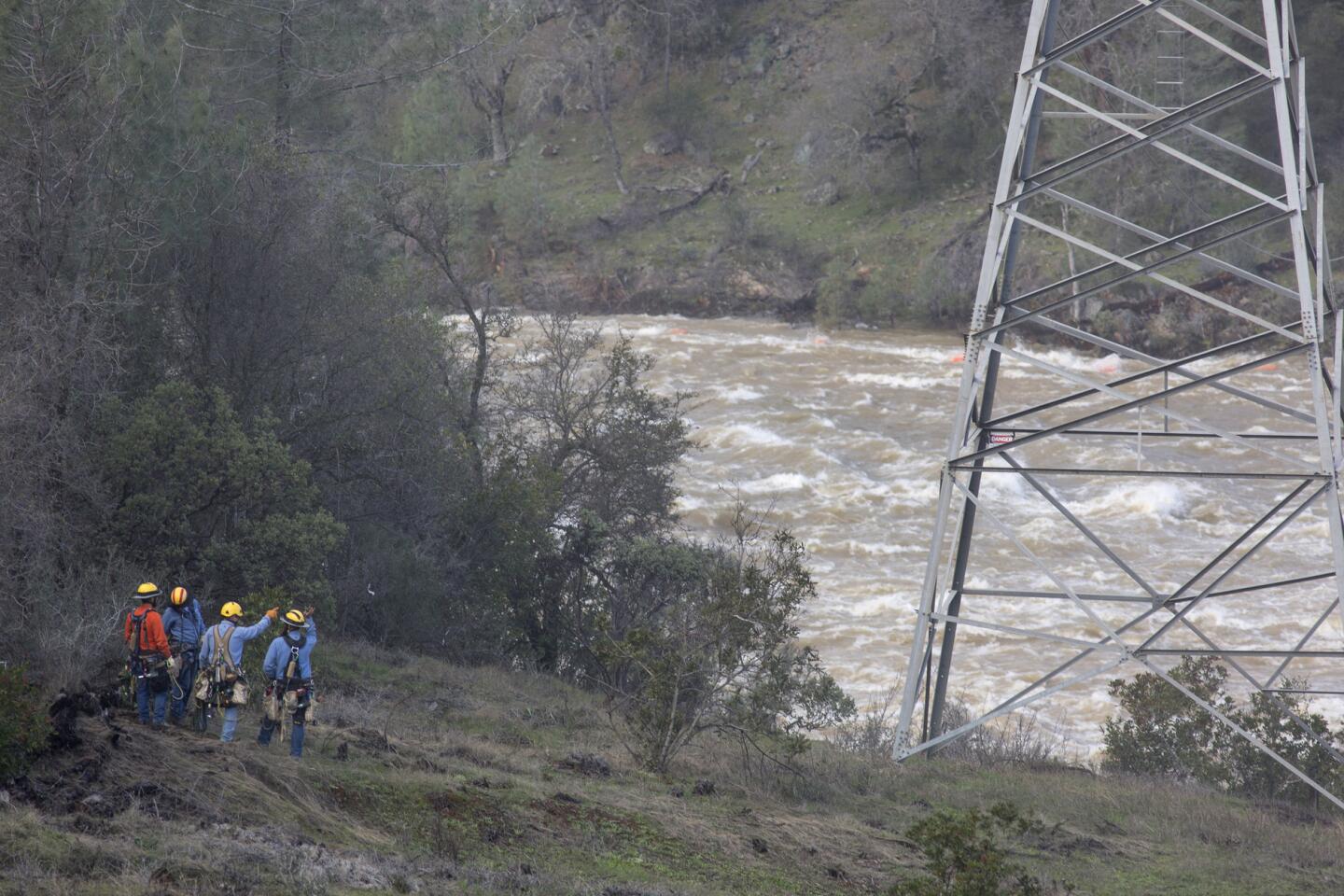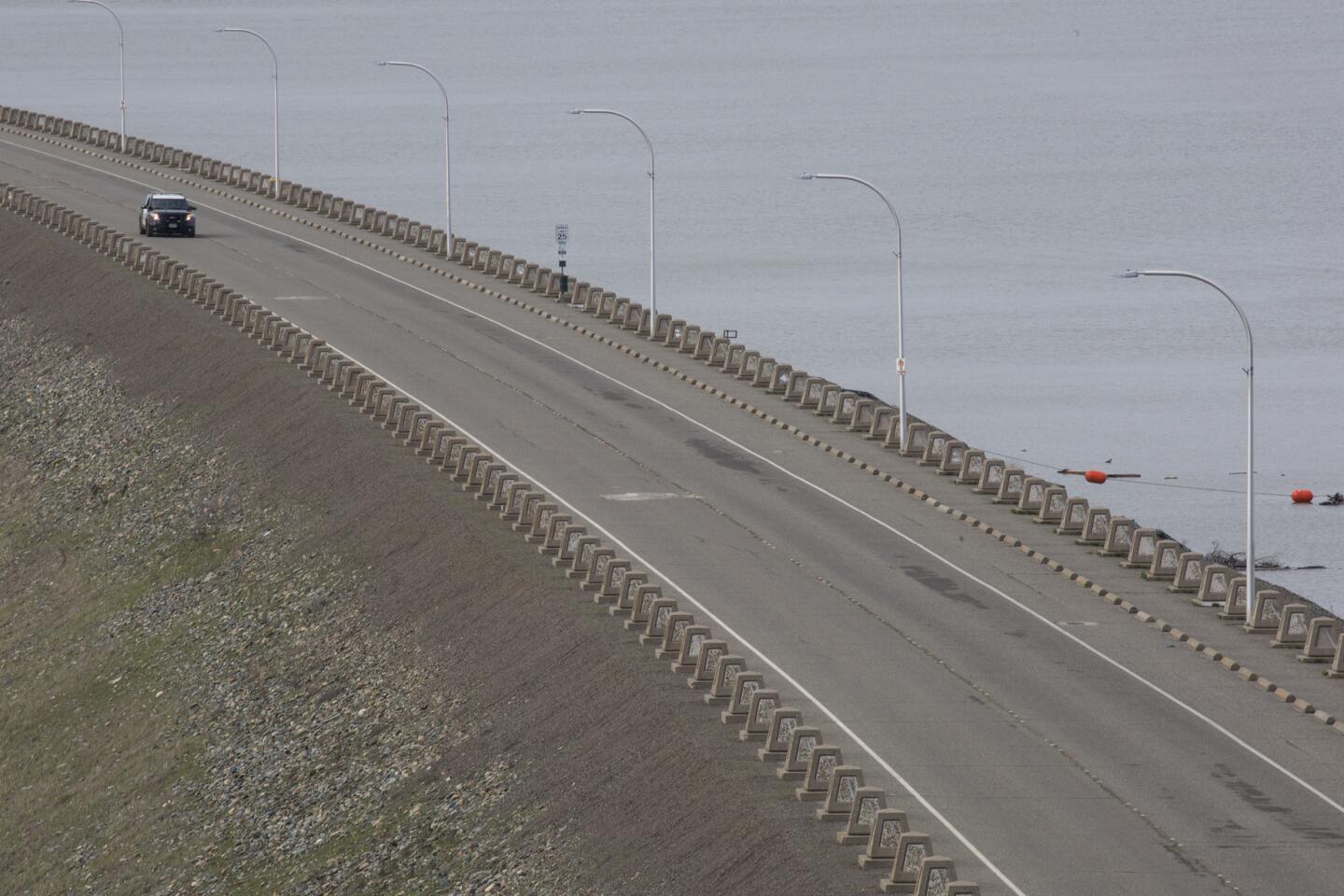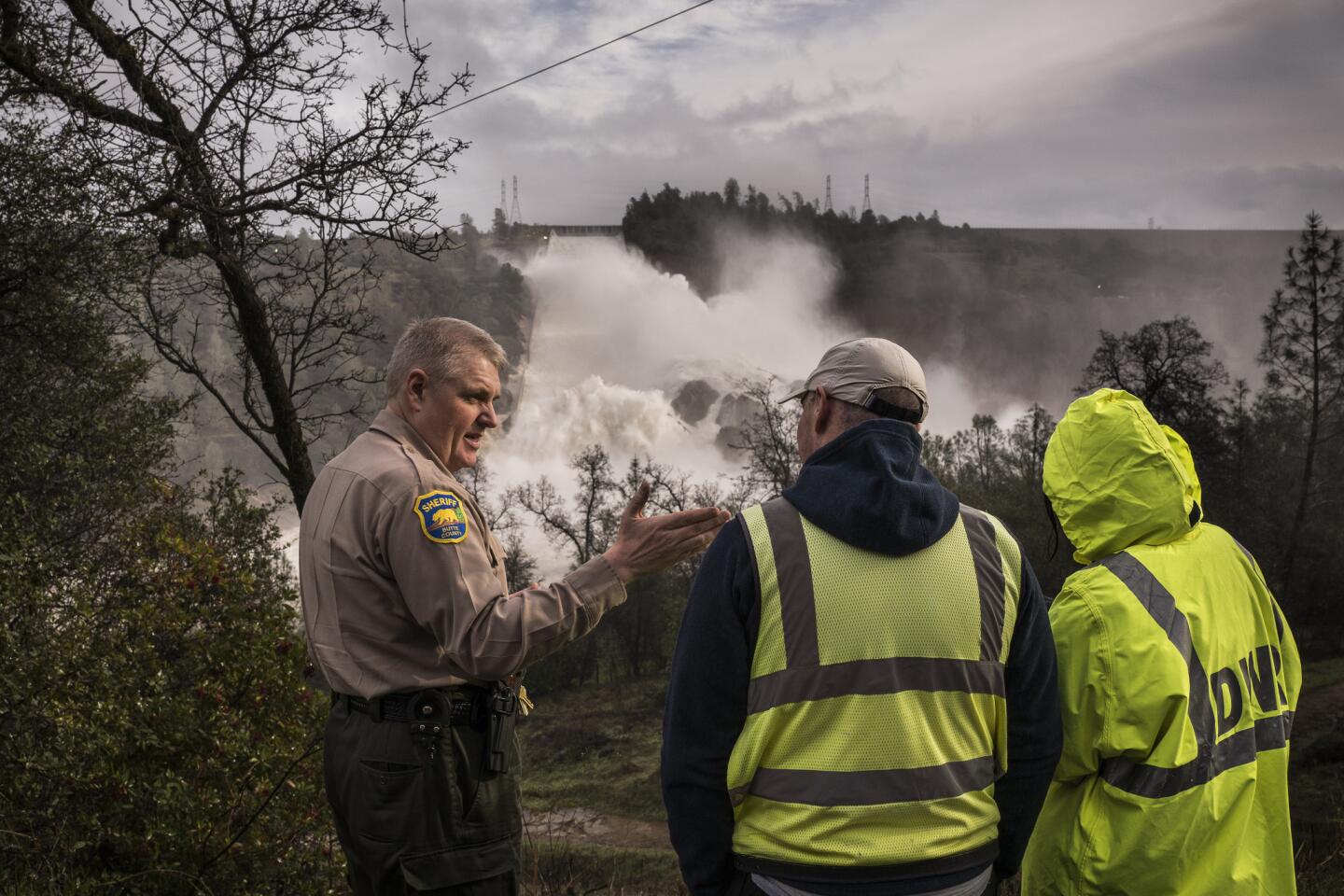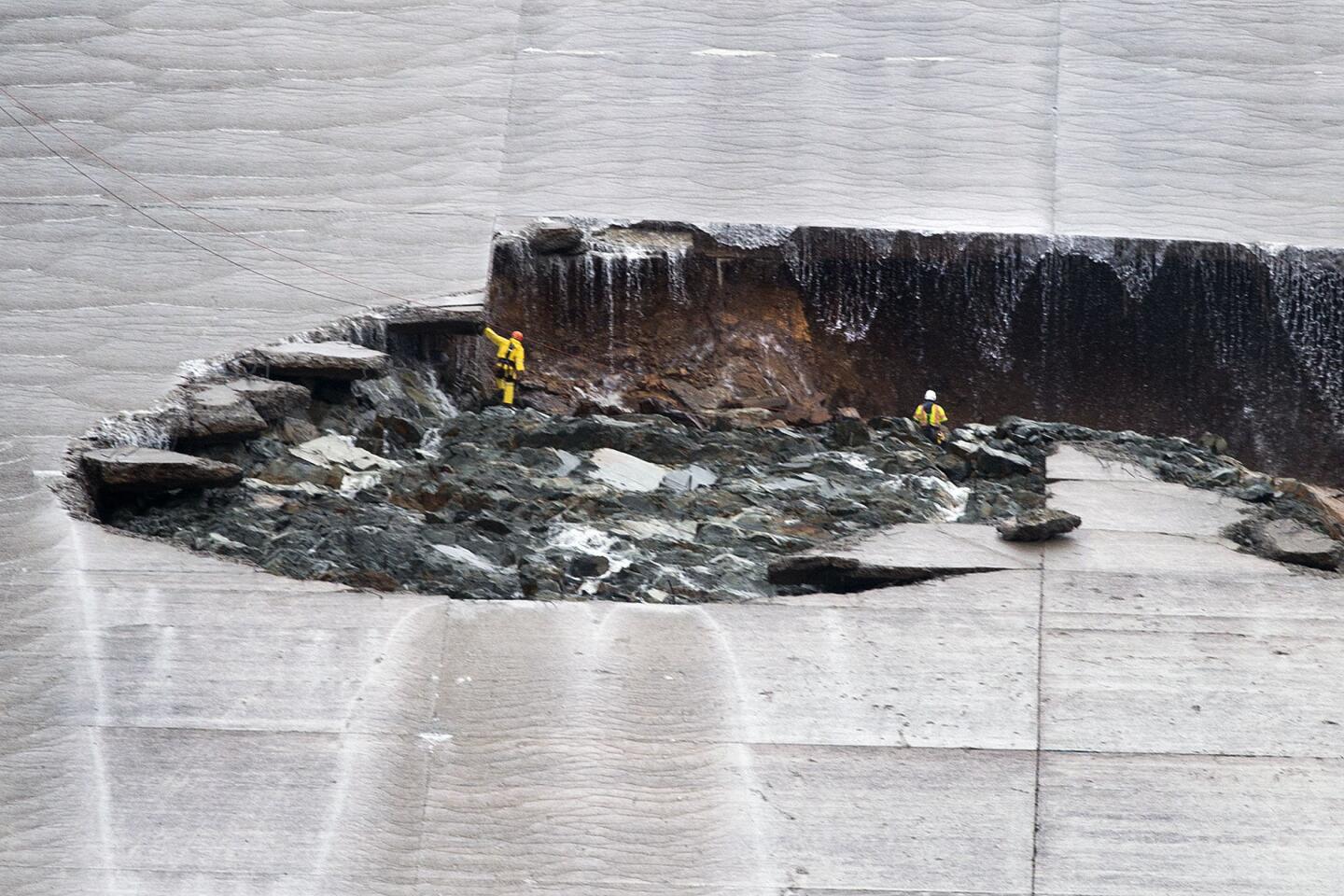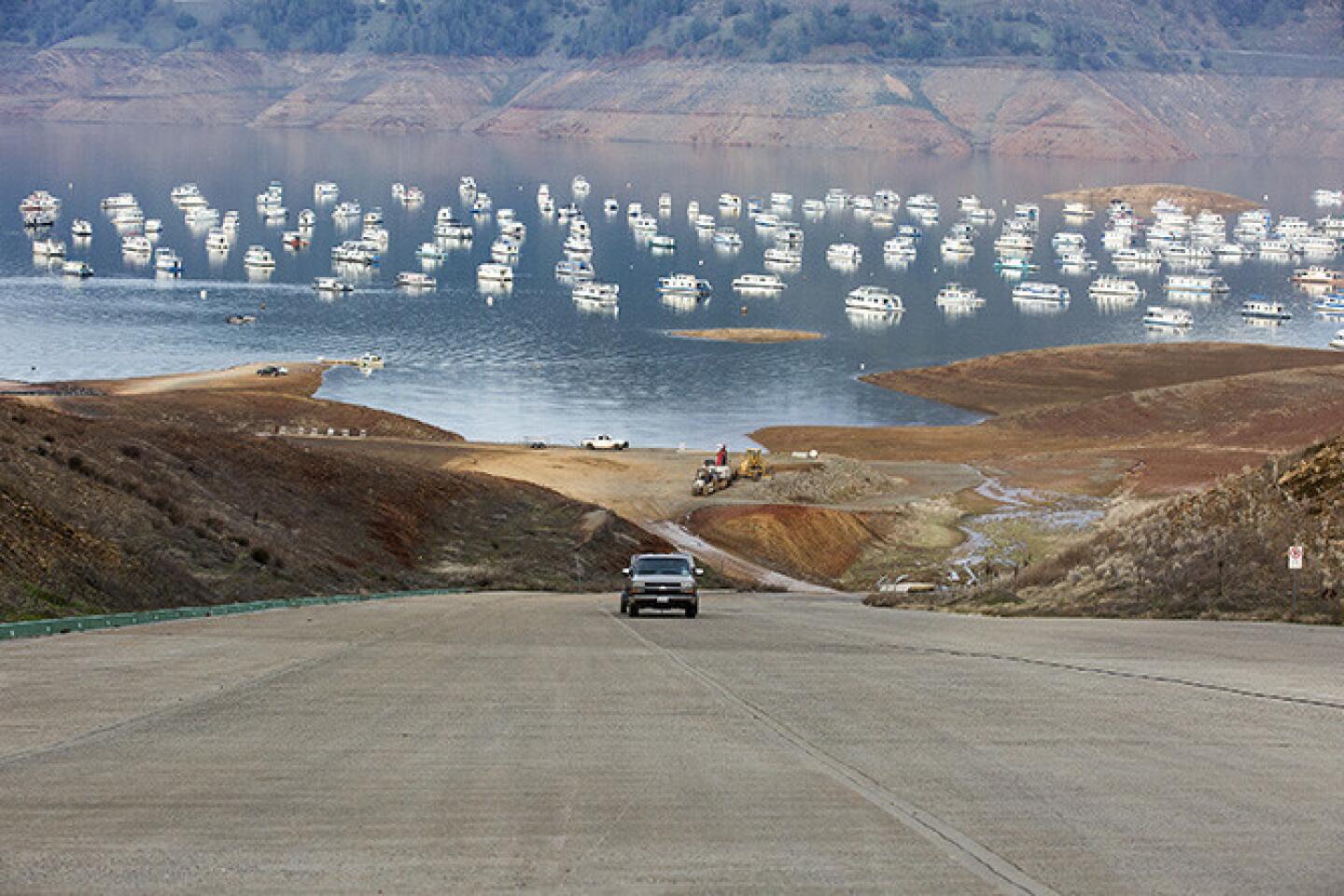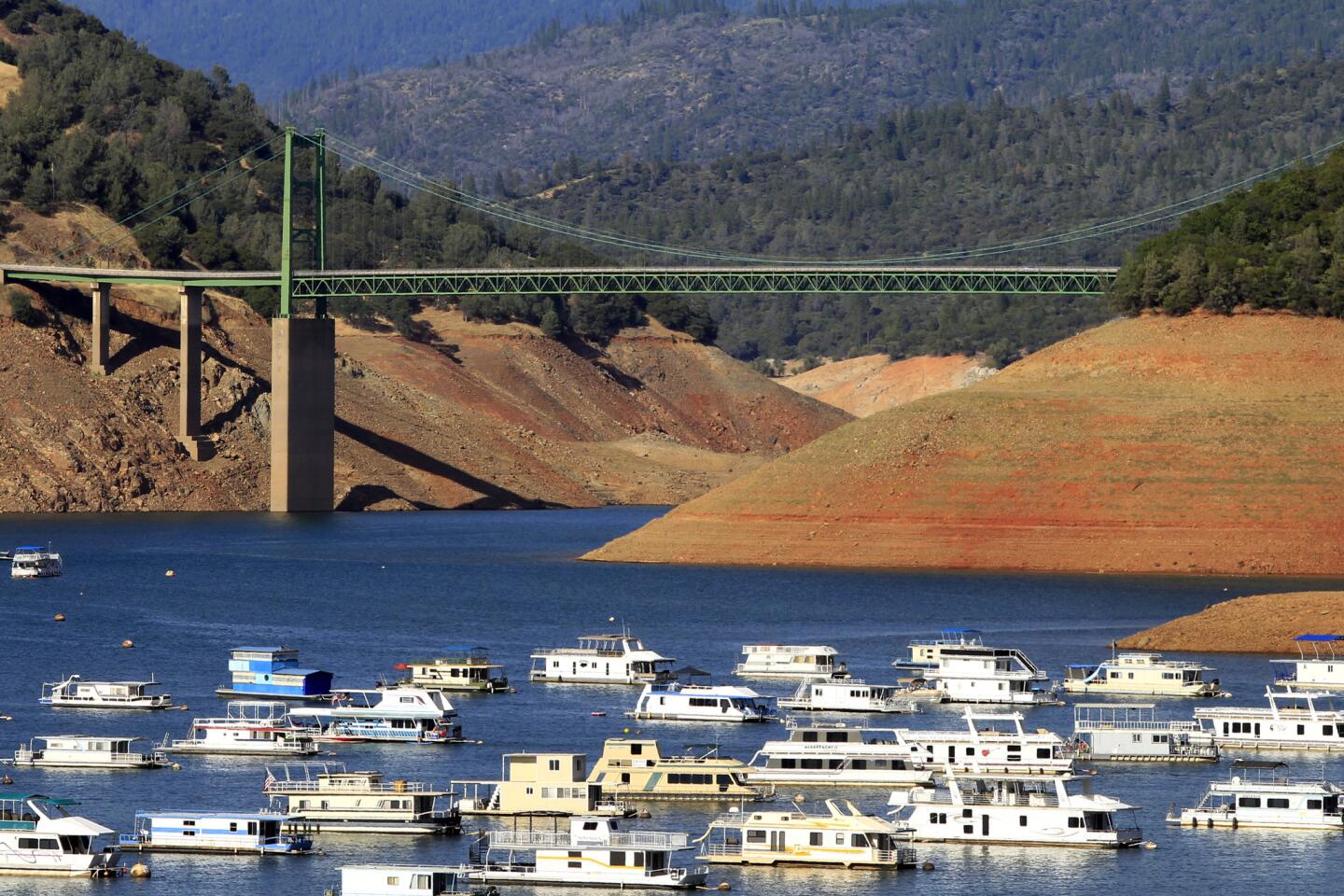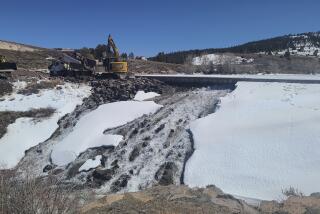Reporting from OROVILLE, CALIF. — At Oroville Dam on Friday, it was all about maintaining a delicate balance.
For days, officials have been rapidly reducing the water level of the massive reservoir after both dam spillways sustained major damage. Now they are expressing confidence that the situation was stable even as rain fell.
Earlier this week, the damaged spillways prompted the evacuation of more than 100,000 people downstream as officials worried the emergency spillway could collapse, prompting a catastrophic flood.
That disaster was averted because officials were able to use the main concrete spillway to reduce reservoir water levels.
On Friday, officials reduced the rate of water release as workers continued repairing a damaged spillways and clear debris from a hydroelectric plant.
The state Department of Water Resources engineers will decrease the flow of water in the Oroville Dam’s main spillway from 80,000 cubic feet per second to 60,000 cfs by Saturday morning, giving crews space to dredge debris from a pool at the bottom of the spillway, said Bill Croyle, the acting director of the DWR.
Engineers had been pumping water out of the lake at 100,000 cfs for several days to make room for incoming storm runoff and to keep the lake from overflowing as it did over the weekend. That overflow badly eroded an emergency spillway and sent debris flowing into a pool at the bottom, forcing the closure of an underground hydroelectric plant.
“This reduction in flow will allow us to work on the debris pile in the spillway,” Croyle told reporters at a news conference. He estimated that 150,000 cubic yards of sediment and debris were in the pool.
The other focus by dam workers is the eroded emergency spillway, Croyle said. Rain began falling again Thursday and it’s not expected to stop until the middle of next week at the earliest.
The heaviest showers are expected Monday and could drop up to 10 inches of rain onto the mountains and foothills that drain into the reservoir, the National Weather Service said.
The storms probably won’t produce enough runoff to exceed the lake’s capacity, Croyle said.
Hundreds of thousands of tons of rocks and concrete slurry have been dropped into four fissures that threatened a retaining wall of the emergency spillway on Sunday.
Rain falling onto the slurry and a small stream that had formed on the hillside Friday did not worry engineers, he said.
The Oroville Dam sits above Oroville and dozens of communities. When the emergency spillway failed last Sunday, officials issued a frantic evacuation order, saying that spillway could give way within an hour.
The spillway didn’t collapse, and residents were allowed to return to their homes within a few days.
Tensions were running high Friday in the region, where residents were growing increasingly worried about a new round of storms and whether those would prompt new evacuations.
For days, DWR officials assured that the incoming storms were expected to be weaker than the ones that bloated the lake a week ago, pushing torrents of debris-laden water over the dam’s main and emergency spillways, damaging both so badly that numerous communities downstream were forced to evacuate.
1/66
An aerial view of the water flowing out of the Oroville Dam main spillway, in Oroville, Calif., on Tuesday, February 21, 2017.
(Marcus Yam / Los Angeles Times) 2/66
An aerial view of the water flowing out of the Oroville Dam’s main spillway on Feb. 21. (Marcus Yam / Los Angeles Times)
3/66
Reduced water releases at the Oroville Dam have made damage to its main spillway more visible. (Marcus Yam / Los Angeles Times)
4/66
With a reduced flow on Sunday, most of the water being released from the Oroville Dam is not going down the spillway; it has broken through and is flowing down the hillside. (Marcus Yam / Los Angeles Times)
5/66
With a reduced flow on Sunday, most of the water being released from the Oroville Dam is not going down the spillway, it’s broken through and is going down the hillside.
(Marcus Yam / Los Angeles Times) 6/66
With a reduced flow on Sunday, most of the water being released from the Oroville Dam is not going down the spillway, it’s broken through and is going down the hillside.
(Marcus Yam / Los Angeles Times) 7/66
Juan Alvarez reassures his girlfriend, Sarah Hendrix, after helping her move out of her home in rural Maxwell. Water was a foot high and crews had to evacuate 100 people because of flooding-- some by boat.
(Marcus Yam / Los Angeles Times) 8/66
Ron Chambers lets Duke out of his crate for the first time in hours since the flooding began n Maxwell, Calif. on Saturday.
(Marcus Yam / Los Angeles Times) 9/66
Kevin Anfinson and other volunteers help shovel the muddy sediment that has built up in the salmon raceway at the Feather River Fish Hatchery in Oroville, Calif. (Marcus Yam / Los Angeles Times)
10/66
Fernando Martinez and his mother, not pictured, wade through a road in Gridley, Calif., flooded by the Feather River as it continues to swell from the water being let out of Lake Oroville.
(Marcus Yam / Los Angeles Times) 11/66
A man in a 4x4 truck turns around on Gridley Road after having second thoughts about making it across the flooded road, which had been closed.
(Brian van der Brug / Los Angeles Times) 12/66
Randy Boheim packs up his tools and emergency supplies in anticipation of having to evacuate his whole family as floodwaters creep closer to his home in an Oroville, Calif., mobile home park. The nearby Feather River continued to swell from the water being let out of Lake Oroville ahead of this weekend’s storm.
(Marcus Yam / Los Angeles Times) 13/66
A plantation in Oroville, Calif., sits in floodwaters as the Feather River continues to swell from the water being let out of Lake Oroville ahead of this weekend’s storm.
(Marcus Yam / Los Angeles Times) 14/66
Helicopters ferry sand and rocks to the Oroville Dam’s emergency spillway reconstruction project in Oroville, Calif., ahead of coming rains.
(Brian van der Brug / Los Angeles Times) 15/66
California Water Service district manager Toni Ruggle surveys the Feather River at Bedrock Park downstream from the Oroville Dam.
(Brian van der Brug / Los Angeles Times) 16/66
McKenna Harvey, 9, left, Kylie Atteberry, 11, and Brooklyn Atteberry, 7, hold signs thanking workers in the repair effort at the Oroville Dam.
(Brian van der Brug / Los Angeles Times) 17/66
A helicopter flies over as water flows from the main spillway at Lake Oroville. (Marcus Yam / Los Angeles Times)
18/66
Reconstruction continues in a race to shore up the emergency spillway at Oroville Dam. (Brian van der Brug / Los Angeles Times)
19/66
As rain clouds gather, friends from left, Johnny Eroh, Cody Balmer, Kristien Bravo and Jerel Bruhn hang out by the flooded Feather river in the Bedrock neighborhood of Oroville, Calif., last week. (Marcus Yam / Los Angeles Times)
20/66
Evacuees at the Bangor Community Hall in Bangor, Calif., listen to Butte County sheriff’s deputies in February as the mandatory evacuation order was lifted. An evacuation advisory was lifted Wednesday. (Brian van der Brug / Los Angeles Times)
21/66
Evacuees at the Bangor Community Hall get the news from Butte County sheriff’s Deputy Jeff Heath that the evacuation order has been lifted.
(Brian van der Brug / Los Angeles Times) 22/66
Evacuee Sharon Dalton, right, hugs Raiden Ellis, 10 months, and Chris Ellis as they say their goodbyes as she leaves the Bangor Community Hall in Bangor, Calif., on Tuesday.
(Brian van der Brug / Los Angeles Times) 23/66
David McGlamery returns to his Oroville home with his belongings after the evacuation order was lifted. The family had to retreat to Chico, where they initially stayed at a Walmart parking lot with other evacuees. (Marcus Yam / Los Angeles Times)
24/66
Bill Tirey helps family members move back into their home in the Bedrock neighborhood of Oroville near the Feather River after evacuation orders were lifted.
(Marcus Yam / Los Angeles Times) 25/66
Maria Alancar returns home to greets her pet pig Bacon, who was left behind when the family moved to higher ground in Honcut, Calif.
(Brian van der Brug / Los Angeles Times) 26/66
Sulet Lopez, 21, left, Melissa Mendoza, 3, and Yeanet Lopez, 18, pack up their car at the Bangor Community Hall in Bangor, Calif., to head home after the evacuation order was lifted.
(Brian van der Brug / Los Angeles Times) 27/66
Erica Stenholm, left, Ronnie Vaughan, and Brooklyn Jackson, 7, unpack their car upon returning home after the evacuation order had been lifted in Oroville.
(Marcus Yam / Los Angeles Times) 28/66
Jonah Avina, left, and his wife, Eileen, pray before lunch at the Maranatha Mennonite Fellowship in Bangor, Calif., on Tuesday. The Bangor-area Mennonites are hosting several immigrant families evacuated from the nearby town of Honcut.
(Brian van der Brug / Los Angeles Times) 29/66
Evacuee Estafani Reynoso, left, colors with Mennonite children at the Maranatha Mennonite Fellowship in Bangor, Calif.
(Brian van der Brug / Los Angeles Times) 30/66
Crews work on a damaged section of the emergency spillway at Lake Oroville on Monday. (Josh Edelson / AFP/ Getty Images)
31/66
An Oroville property is flooded on Monday as thousands were under evactuation orders.
(Josh Edelson / AFP/Getty Images) 32/66
The Marysville cemetery underwater along the Feather River.
(Marcus Yam / Los Angeles Times) 33/66
Nirmal Singh, a Sikh priest, conducts a morning prayer ritual as evacuees sleep in the background at the Shri Guru Ravidass, a Sikh temple that has opened its doors for evacuees of the Oroville Dam crisis in Rio Linda, Calif.
(Marcus Yam / Los Angeles Times) 34/66
Kamlesh Nahar, far left, talks to fellow evacuees at the Shri Guru Ravidass Temple.
(Marcus Yam / Los Angeles Times) 35/66
Maria Lopez reads on her smartphone as she spends a second night in her father’s car in the parking lot of the Bangor Community Hall.
(Brian van der Brug / Los Angeles Times) 36/66
Sharon Dalton finds a quiet spot under a table as she spends a second night with her dog Cruiser inside the Bangor Community Hall.
(Brian van der Brug / Los Angeles Times) 37/66
Verna Chadwick and 10-month-old son Raiden Ellis during a second night in the Bangor Community Hall.
(Brian van der Brug / Los Angeles Times) 38/66
The emergency spillway, left, and the damaged main spillway at Lake Oroville are seen in an aerial photo Monday.
(Elijah Nouvelage / Getty Images) 39/66
A dump truck crosses the primary spillway to deliver boulders to the damaged emergency spillway at Lake Oroville on Monday evening.
(Brian van der Brug / Los Angeles Times) 40/66
Helicopters place large rocks on the damaged emergency spillway at Lake Oroville on Monday evening.
(Brian van der Brug / Los Angeles Times) 41/66
Around-the-clock monitoring continues on the damaged primary spillway at Lake Oroville on Monday evening.
(Brian van der Brug / Los Angeles Times) 42/66
Water rushes down a spillway at the Oroville Dam. (Brian van der Brug / Los Angeles Times)
43/66
California Department of Fish and Game wardens view the damaged spillway on Monday. (Brian van der Brug / Los Angeles Times)
44/66
Bill O’Kelley, 86, and wife Doris O’Kelley, 84, of Oroville sit near a flagpole Monday at the Silver Dollar Fairgrounds evacuation center in Chico, Calif.
(Brian van der Brug / Los Angeles Times) 45/66
Coua Tha, of Oroville prepares a meal for her family in the parking lot at the Silver Dollar Fairgrounds evacuation center in Chico, Calif.
(Brian van der Brug / Los Angeles Times) 46/66
Desiree Garcia and daughter Kay’lee Pearl Garcia, 3, of Oroville look over donated clothing Monday at the Silver Dollar Fairgrounds evacuation center in Chico, Calif.
(Brian van der Brug / Los Angeles Times) 47/66
Members of Oroville’s Jordan Crossing Mission pray with a volunteer service member Monday at the Silver Dollar Fairgrounds evacuation shelter in Chico, Calif.
(Brian van der Brug / Los Angeles Times) 48/66
The swollen Feather River flows through Oroville, Calif., on Monday.
(Rich Pedroncelli / Associated Press) 49/66
A building is submerged in Riverbend Park as more water is released from Lake Oroville.
(JOSH EDELSON / AFP) 50/66
Siblings Zach Soto, 11, left, and Gabby Soto, 13, keep an eye on the Feather River along a railroad bridge in Oroville, Calif., on Monday. The family decided to stay in Oroville as they live on high ground near downtown.
(Brian van der Brug / Los Angeles Times) 51/66
Water flows down the damaged main spillway of the Oroville Dam at 55,000 cubic feet per second into the Feather River. (Brian van der Brug / Los Angeles Times)
52/66
Water from Lake Oroville flows down the damaged main spillway.
(Brian van der Brug / Los Angeles Times) 53/66
Water from Lake Oroville flows down the emergency spillway of the Oroville Dam toward the Feather River.
(Brian van der Brug / Los Angeles Times) 54/66
Pacific Gas & Electric crews aided by a helicopter removed transmission lines and insulators from towers standing in the bed of the emergency spillway of Lake Oroville.
(Brian van der Brug / Los Angeles Times) 55/66
A rainbow appears over Feather River as water cascades down the damaged spillway at Lake Oroville Dam.
(Brian van der Brug / Los Angeles Times) 56/66
Water cascades down the spillway below Oroville Dam. The water is being released by authorities to avoid flooding at Lake Oroville because of recent heavy rain. (David Butow / For The Times)
57/66
Pacific Gas and Electric Co. crews move two electric transmission line towers on the bank of Feather River as a precaution if the Lake Oroville Dam emergency spillway needs to be used.
(Brian van der Brug / Los Angeles Times) 58/66
A California Highway Patrol cruiser patrols Lake Oroville Dam, which is closed to the public due to the damaged spillway.
(Brian van der Brug / Los Angeles Times) 59/66
Water cascades down the spillway below the Oroville dam. The water is being released by authorities to ease flooding in Lake Oroville because of recent heavy rain.
(David Butow / For the Times) 60/66
Butte Country Sheriff Kory L. Honea speaks with department of water and power workers at an overlook as the observe runoff from the Oroville Dam.
(David Butow / For the Times) 61/66
Water trickles down as workers inspect part of the Lake Oroville spillway failure in Oroville, Calif.
(Randy Pench / Associated Press) 62/66
A boat launch at Bidwell Canyon is still hundreds of yards above the current lake level on Jan. 21, 2016.
(Brian van der Brug / Los Angeles Times) 63/66
California State Park Ranger Bryan Taylor searches for signs of disturbance or theft as California’s severe drought conditions are revealing historic artifacts at Lake Oroville, June 21, 2014.
(Allen J. Schaben / Los Angeles Times) 64/66
Severe drought conditions are evident as a family treks across a long path back to their car at Lake Oroville, June 21, 2014.
(Allen J. Schaben / Los Angeles Times) 65/66
Houseboats are dwarfed by steep banks that show the water level down 160 feet from the high water mark at the Bidwell Bar Suspension Bridge over Lake Oroville on June 21, 2014.
(Allen J. Schaben / Los Angeles Times) 66/66
Houseboats at Bidwell Canyon Marina at Lake Oroville, January 21, 2016.
(Brian van der Brug / Los Angeles Times) So hearts sank among some residents Friday when the National Weather Service issued a revised forecast warning that the largest storm in that atmospheric river could drop as much as 12 inches of warm rain between Sunday and Tuesday in the area surrounding the site where crews have been dumping 120,000 tons of boulders and cement per hour onto deep fissures gouged into the unpaved earthen emergency spillway of the nation’s tallest dam.
Periods of warm rain and strong winds are expected to rake the area into the week.
As rain fell hard Friday in Oroville, Dorman Lard, an independent contractor, sat by himself in a coffee shop early Friday morning, watching mixers and trucks loaded with massive boulders speeding past toward the stricken dam.
“State officials are trying not to create a panic,” said Lard, 85. “They have to walk a very fine line, because there’s so much uncertainty. For us, however, it’s a bad dream.
“How many evacuations can we withstand? One is plenty,” he said.
louis.sahagun@latimes.com
ALSO
Live updates: Strongest storm in years moves into L.A. area
Will the crisis at Oroville Dam become a catalyst for change?
Downstream from the stricken Oroville Dam, the Feather River Fish Hatchery manages to save millions of fish
